Comprehensive Evaluation of the Development Level of China’s Characteristic Towns under the Perspective of an Urban–Rural Integration Development Strategy
Abstract
:1. Introduction
1.1. Literature Review
1.2. Current Status of Research
1.2.1. Sustainable Development Strategies and New Urbanization
1.2.2. Rural Rejuvenation
1.2.3. Characteristic Town
2. Materials and Methods
2.1. Construction of the Evaluation Indicator System for the Development Level of Characteristic Towns
2.1.1. Principles for the Selection of Evaluation Indicators
2.1.2. Construction of the Evaluation Indicator System
2.2. Assessment Model for the Development Level of Characteristic Towns
2.2.1. Rough Set and Conditional Information Entropy Theory
2.2.2. TOPSIS Modeling Steps
3. Results
3.1. Constructing a Scoring Matrix
3.2. Data Pre-Processing
3.3. Calculate the Correlation Matrix
3.4. Gray Association Clustering
3.5. Simplicity of Indicators
3.6. Synthesized Assessment
4. Discussion
4.1. Data Collection
4.2. Evaluation Using the TOPSlS Method
- (1)
- Normalize the raw scoring data to obtain the matrix F:
- (2)
- Calculate the positive and negative ideal solutions from the determined matrix F.
- (3)
- A brief introduction of the evaluated featured towns (see Table 7), with the average of the experts’ scores as the initial data (see Table 8). Combining the weights of the indicators and the comprehensive evaluation value, determine the Euclidean distance of each featured town from the positive and negative ideal solutions, as well as the relative closeness ζ, and rank each featured town (see Table 9).
5. Conclusions
Author Contributions
Funding
Data Availability Statement
Conflicts of Interest
Appendix A. The Results of the Expert Scored Dimensionless Data
| norm | y1 | y2 | y3 | y4 | y5 | y6 | y7 | y8 | y9 | y10 | y11 | y12 | y13 | y14 | y15 | y16 | y17 | y18 | y19 | y20 | y21 | y22 | y23 | y24 | y25 |
| X1 | 0.652 | 0.130 | 0.652 | 0.652 | 0.609 | 0.391 | 0.652 | 0.652 | 1.000 | 0.652 | 0.565 | 0.652 | 0.217 | 0.609 | 0.000 | 0.652 | 0.565 | 0.652 | 0.652 | 0.609 | 0.783 | 0.652 | 0.652 | 1.000 | 0.609 |
| X2 | 0.500 | 0.050 | 0.850 | 0.650 | 0.400 | 0.000 | 0.500 | 0.550 | 0.900 | 0.500 | 0.550 | 1.000 | 0.150 | 0.400 | 0.000 | 0.500 | 0.550 | 0.600 | 0.650 | 0.400 | 0.500 | 0.500 | 0.550 | 0.900 | 0.600 |
| X3 | 0.375 | 0.438 | 0.750 | 0.625 | 0.625 | 0.000 | 0.375 | 0.500 | 0.813 | 0.813 | 0.438 | 0.750 | 0.500 | 0.625 | 0.000 | 0.813 | 0.438 | 0.750 | 0.813 | 0.625 | 1.000 | 0.375 | 0.500 | 0.813 | 0.938 |
| X4 | 0.571 | 0.571 | 0.857 | 0.857 | 0.000 | 0.000 | 0.571 | 0.000 | 0.714 | 1.000 | 0.571 | 0.857 | 0.143 | 0.000 | 0.000 | 1.000 | 0.571 | 0.857 | 0.857 | 0.000 | 0.571 | 0.571 | 0.000 | 0.714 | 0.571 |
| X5 | 1.000 | 0.857 | 0.714 | 0.786 | 1.000 | 0.000 | 0.643 | 0.286 | 0.643 | 1.000 | 0.857 | 0.714 | 0.071 | 1.000 | 0.000 | 1.000 | 0.857 | 0.714 | 0.786 | 1.000 | 0.643 | 0.929 | 0.286 | 0.643 | 0.786 |
| X6 | 0.694 | 0.500 | 0.889 | 0.306 | 0.528 | 0.250 | 0.889 | 0.722 | 0.444 | 0.778 | 0.000 | 0.889 | 0.583 | 0.694 | 0.167 | 0.389 | 0.056 | 0.889 | 0.861 | 0.194 | 0.972 | 0.889 | 0.722 | 1.000 | 0.556 |
| X7 | 0.833 | 0.767 | 0.933 | 0.900 | 0.967 | 0.000 | 0.600 | 0.800 | 0.933 | 0.833 | 1.000 | 0.933 | 0.900 | 0.967 | 0.000 | 0.833 | 1.000 | 0.933 | 0.900 | 0.967 | 0.933 | 0.600 | 0.800 | 0.933 | 0.867 |
| X8 | 0.800 | 0.333 | 0.733 | 0.700 | 0.867 | 0.000 | 0.767 | 0.700 | 0.767 | 0.800 | 1.000 | 0.733 | 0.367 | 0.867 | 0.000 | 0.800 | 1.000 | 0.733 | 0.700 | 0.867 | 0.833 | 0.467 | 0.533 | 0.700 | 0.767 |
| X9 | 0.763 | 0.263 | 0.632 | 0.816 | 0.947 | 0.289 | 0.868 | 0.895 | 0.921 | 0.974 | 0.947 | 0.895 | 0.816 | 0.947 | 0.000 | 0.974 | 0.947 | 0.895 | 0.816 | 0.947 | 0.868 | 0.816 | 0.974 | 0.895 | 1.000 |
| X10 | 0.867 | 0.600 | 0.800 | 0.933 | 0.867 | 0.000 | 0.933 | 0.733 | 0.900 | 0.867 | 0.867 | 0.800 | 0.933 | 0.867 | 0.000 | 0.867 | 0.867 | 0.800 | 0.933 | 0.867 | 0.900 | 0.267 | 1.000 | 0.667 | 0.800 |
| X11 | 0.879 | 0.424 | 0.061 | 0.394 | 0.818 | 0.000 | 0.303 | 0.970 | 0.697 | 0.879 | 0.909 | 0.788 | 0.697 | 0.970 | 0.000 | 0.879 | 0.515 | 0.788 | 0.697 | 0.424 | 0.758 | 0.606 | 1.000 | 0.788 | 0.909 |
| X12 | 0.727 | 0.773 | 0.773 | 0.864 | 0.864 | 0.000 | 1.000 | 0.864 | 0.864 | 0.727 | 0.955 | 0.455 | 0.773 | 1.000 | 0.000 | 0.727 | 0.955 | 0.455 | 0.773 | 1.000 | 0.773 | 0.909 | 0.909 | 0.727 | 0.273 |
| X13 | 0.923 | 0.423 | 0.808 | 0.654 | 0.115 | 0.269 | 0.769 | 0.769 | 0.808 | 0.769 | 0.846 | 0.846 | 0.808 | 1.000 | 0.077 | 0.769 | 0.846 | 0.000 | 0.808 | 1.000 | 0.692 | 0.923 | 0.846 | 0.308 | 0.808 |
| X14 | 1.000 | 0.433 | 0.667 | 0.833 | 0.867 | 0.000 | 0.967 | 0.633 | 0.700 | 1.000 | 0.833 | 0.900 | 0.867 | 0.967 | 0.000 | 1.000 | 0.833 | 0.900 | 0.867 | 0.967 | 0.700 | 0.667 | 0.767 | 0.800 | 0.800 |
| X15 | 0.966 | 0.138 | 0.931 | 1.000 | 1.000 | 0.207 | 0.241 | 0.931 | 0.793 | 0.966 | 0.966 | 0.931 | 0.931 | 0.000 | 0.207 | 0.966 | 0.966 | 0.931 | 0.069 | 0.862 | 0.793 | 0.345 | 0.759 | 0.138 | 0.897 |
| X16 | 0.788 | 0.455 | 0.879 | 0.818 | 0.848 | 0.394 | 0.333 | 0.788 | 0.273 | 0.788 | 0.000 | 0.697 | 0.636 | 0.818 | 0.394 | 0.758 | 0.697 | 0.758 | 0.758 | 0.727 | 0.848 | 0.939 | 0.758 | 1.000 | 0.727 |
| X17 | 0.900 | 0.425 | 0.950 | 0.800 | 0.775 | 1.000 | 0.875 | 0.425 | 0.650 | 0.900 | 0.800 | 0.700 | 0.600 | 0.900 | 0.000 | 0.750 | 0.775 | 0.800 | 0.825 | 0.700 | 0.750 | 0.750 | 0.775 | 0.950 | 0.800 |
| X18 | 0.839 | 0.129 | 0.968 | 0.258 | 0.871 | 0.484 | 0.581 | 0.581 | 0.774 | 0.903 | 0.839 | 1.000 | 0.000 | 0.903 | 0.484 | 0.871 | 0.677 | 0.839 | 0.226 | 0.774 | 0.968 | 0.645 | 0.710 | 0.871 | 0.935 |
| X19 | 0.708 | 0.167 | 1.000 | 0.667 | 0.625 | 0.083 | 0.792 | 0.333 | 0.417 | 0.625 | 0.708 | 0.750 | 0.750 | 0.750 | 0.083 | 0.917 | 0.792 | 0.875 | 0.875 | 0.625 | 0.792 | 0.792 | 0.625 | 0.000 | 0.792 |
| X20 | 0.615 | 0.154 | 0.808 | 0.731 | 0.615 | 0.000 | 0.692 | 0.615 | 0.846 | 0.731 | 0.885 | 0.846 | 0.846 | 0.769 | 0.000 | 1.000 | 0.923 | 0.846 | 0.885 | 1.000 | 0.538 | 0.808 | 0.615 | 0.808 | 0.885 |
| X21 | 0.903 | 0.516 | 0.806 | 0.419 | 0.871 | 0.484 | 0.839 | 0.548 | 0.935 | 0.613 | 0.742 | 0.903 | 0.000 | 0.774 | 0.484 | 0.355 | 1.000 | 0.806 | 0.774 | 0.968 | 0.903 | 0.806 | 0.613 | 0.935 | 0.806 |
| X22 | 1.000 | 0.316 | 0.737 | 0.526 | 0.368 | 0.000 | 0.474 | 0.211 | 0.895 | 0.526 | 0.526 | 0.947 | 0.684 | 0.579 | 0.000 | 0.211 | 1.000 | 0.895 | 0.842 | 0.947 | 0.895 | 0.368 | 0.684 | 0.895 | 0.789 |
Appendix B. Clustering Results after Deletion of Individual Indicators
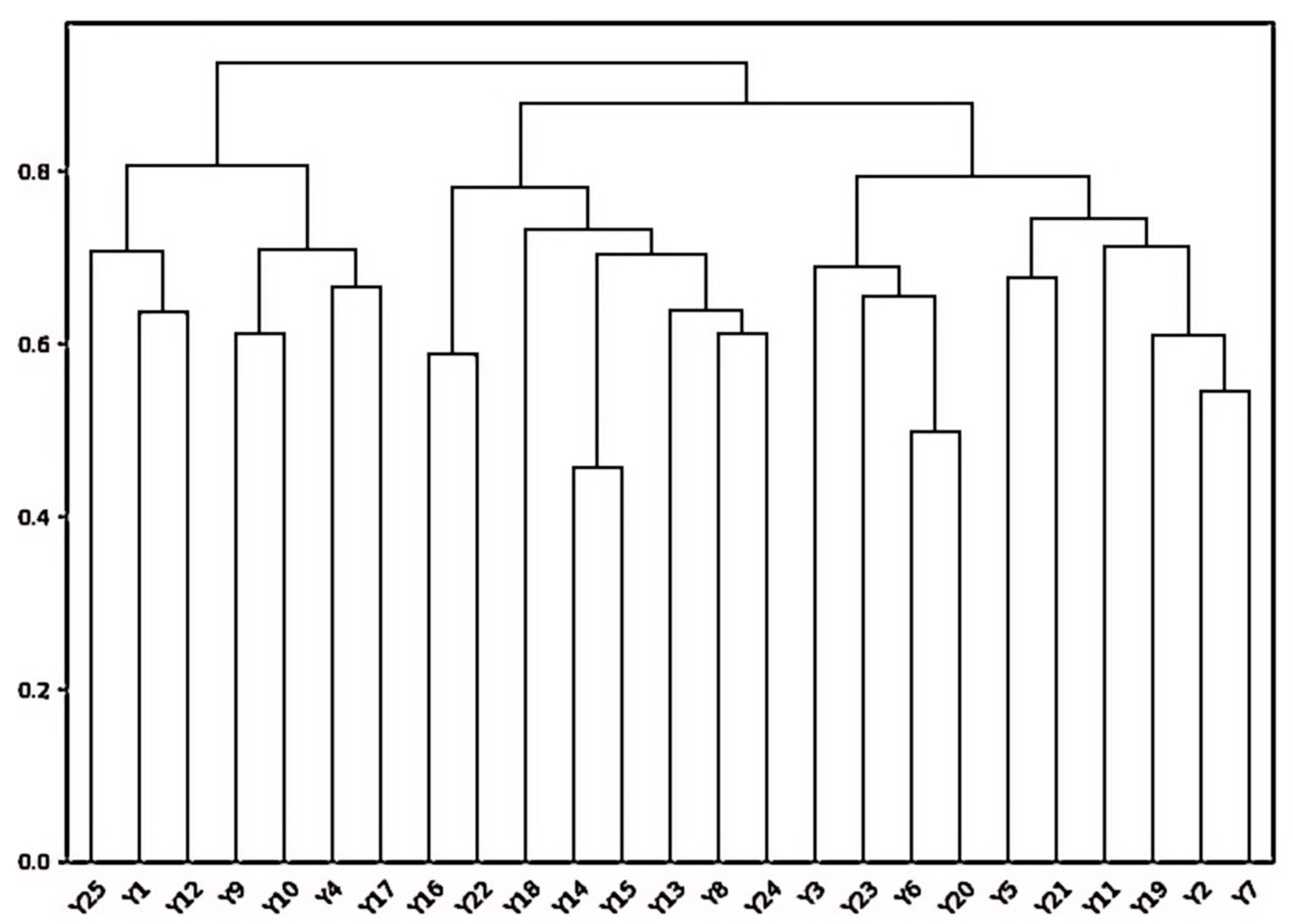
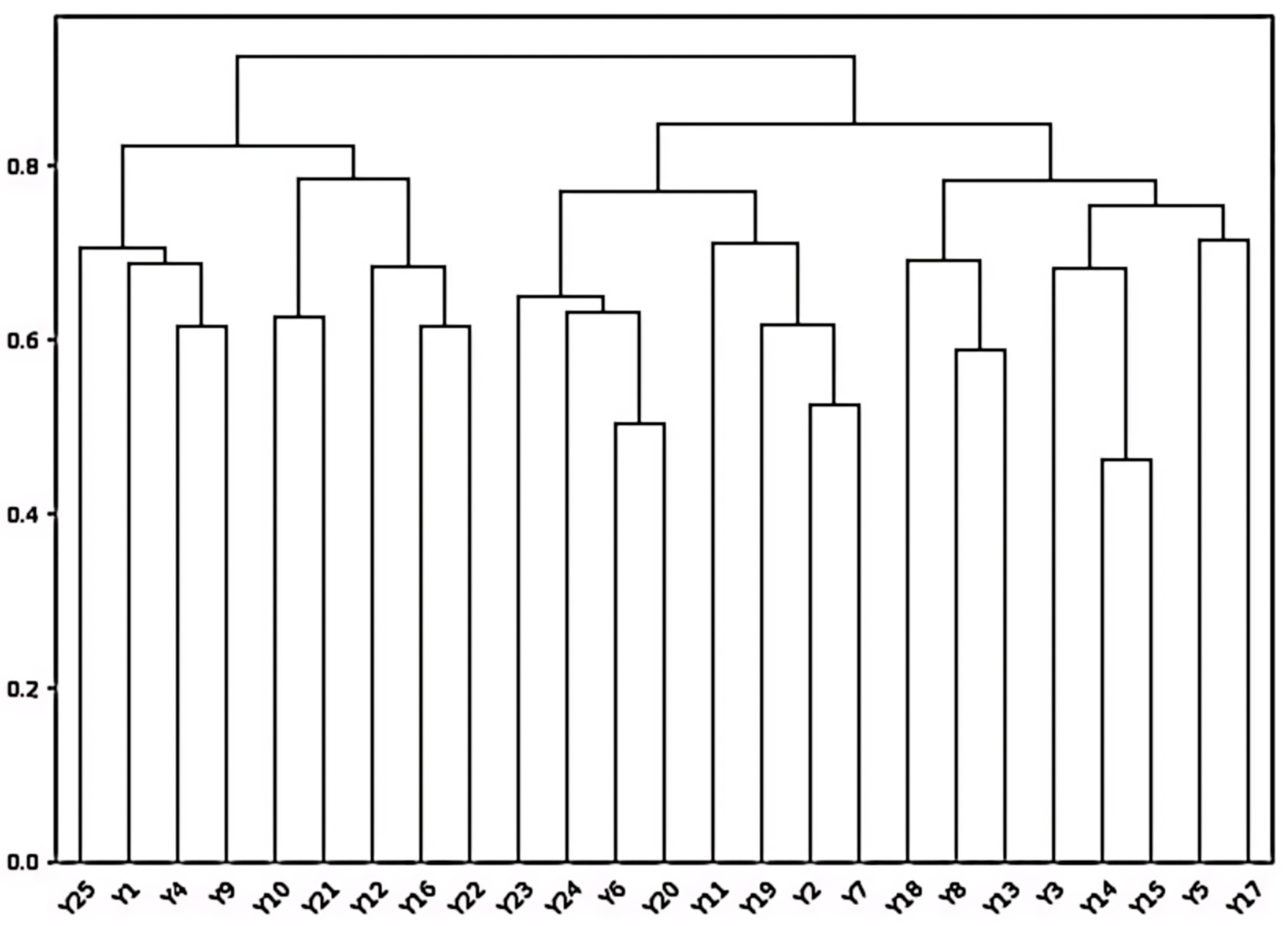


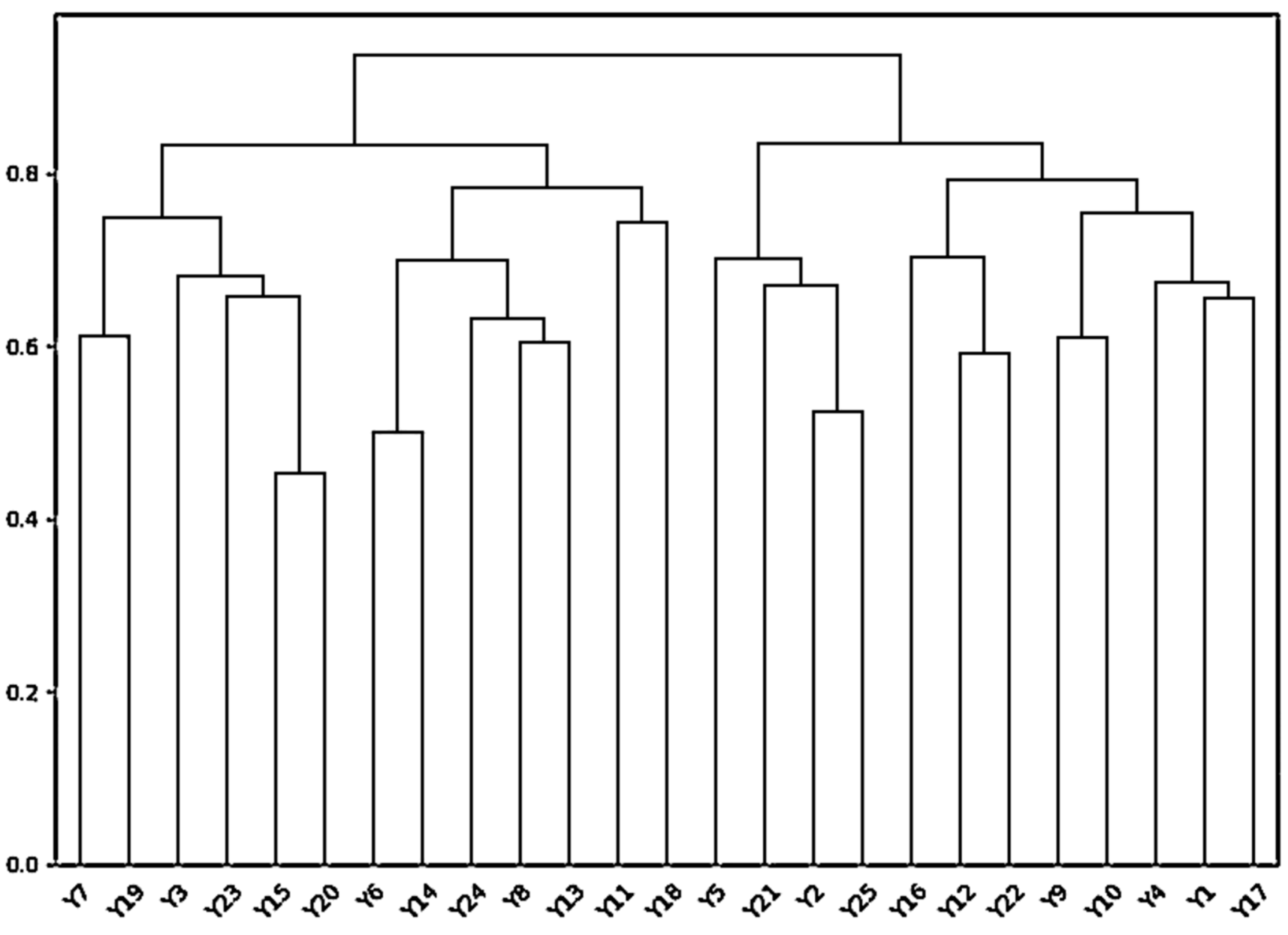
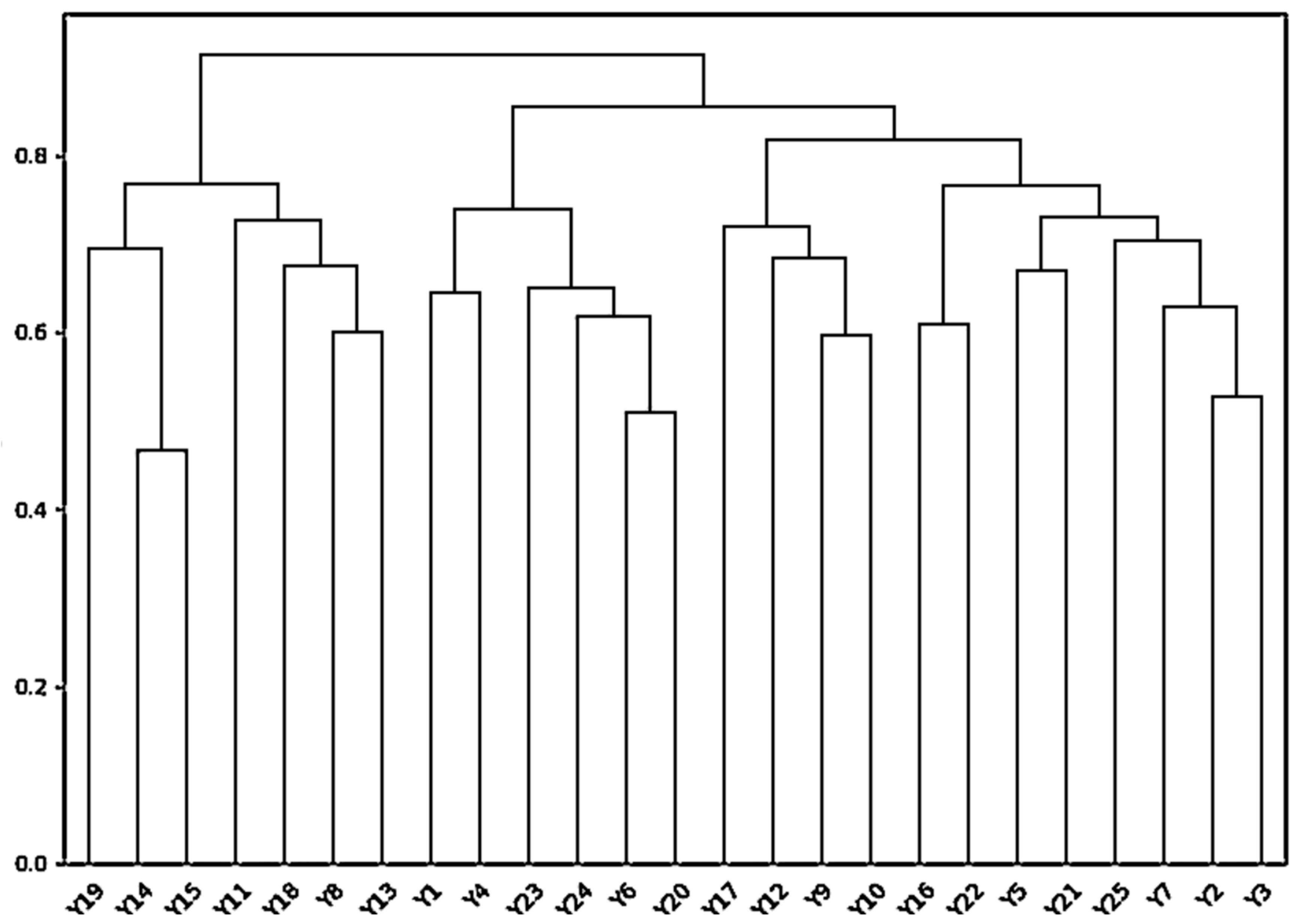
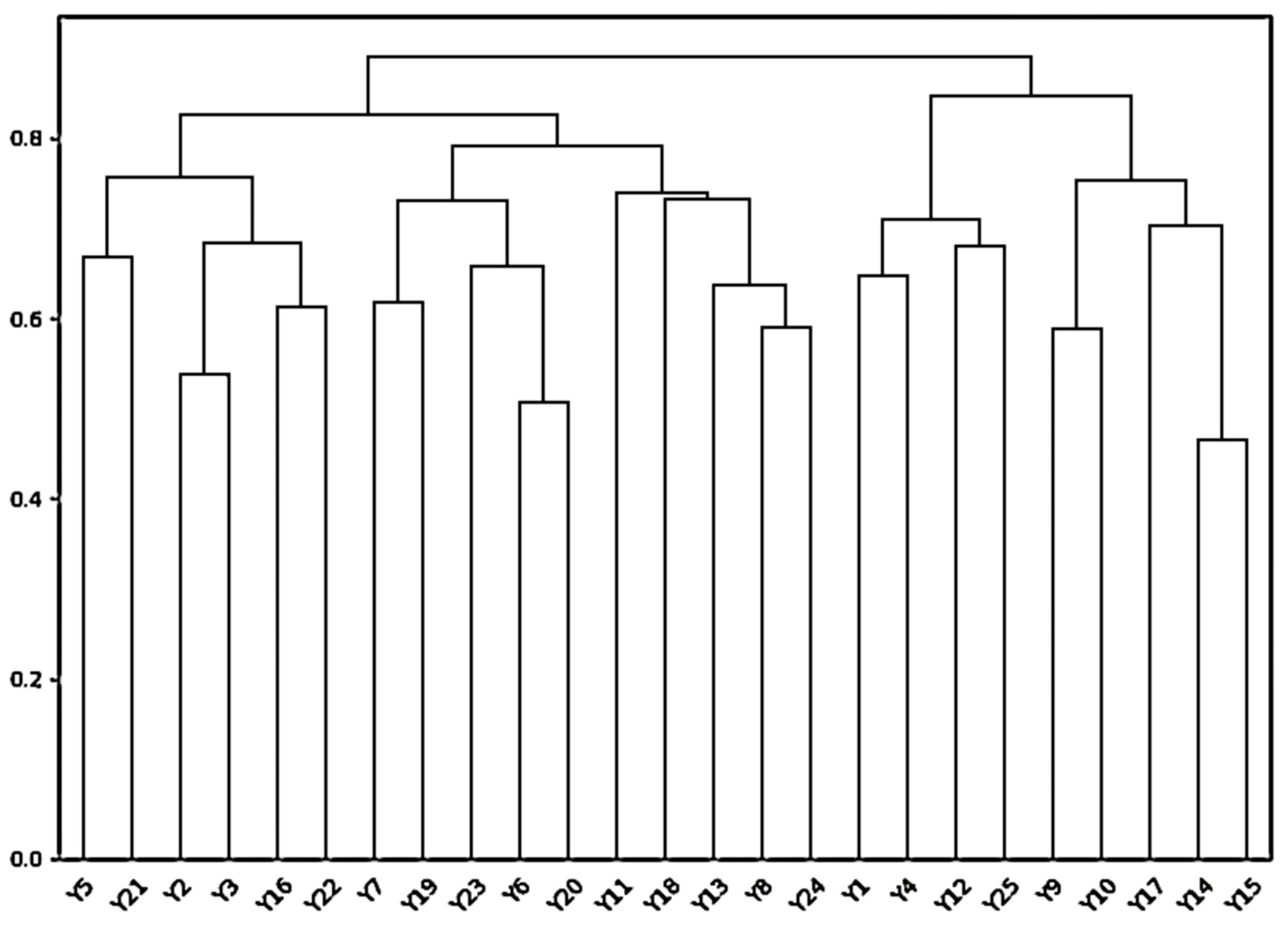
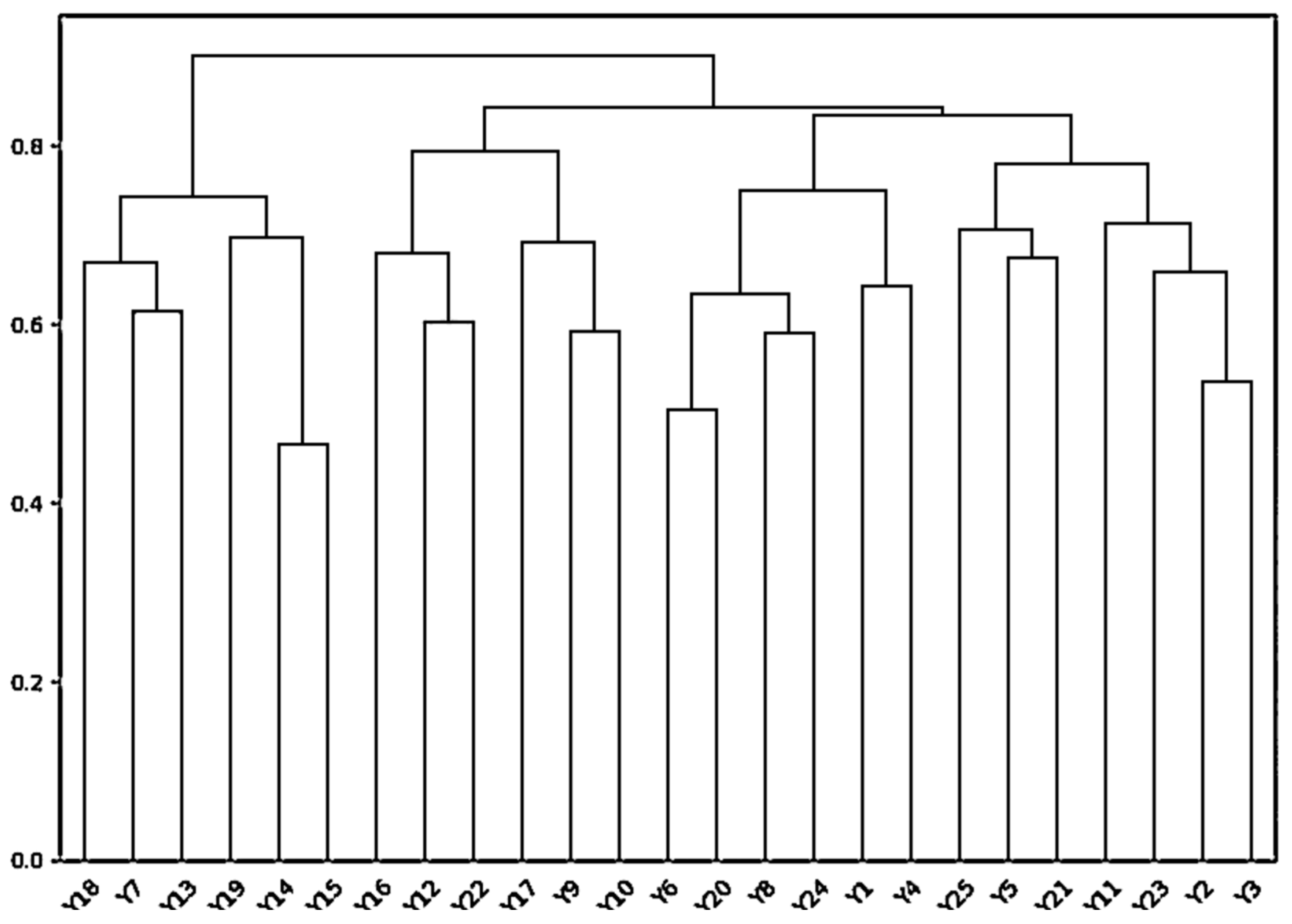
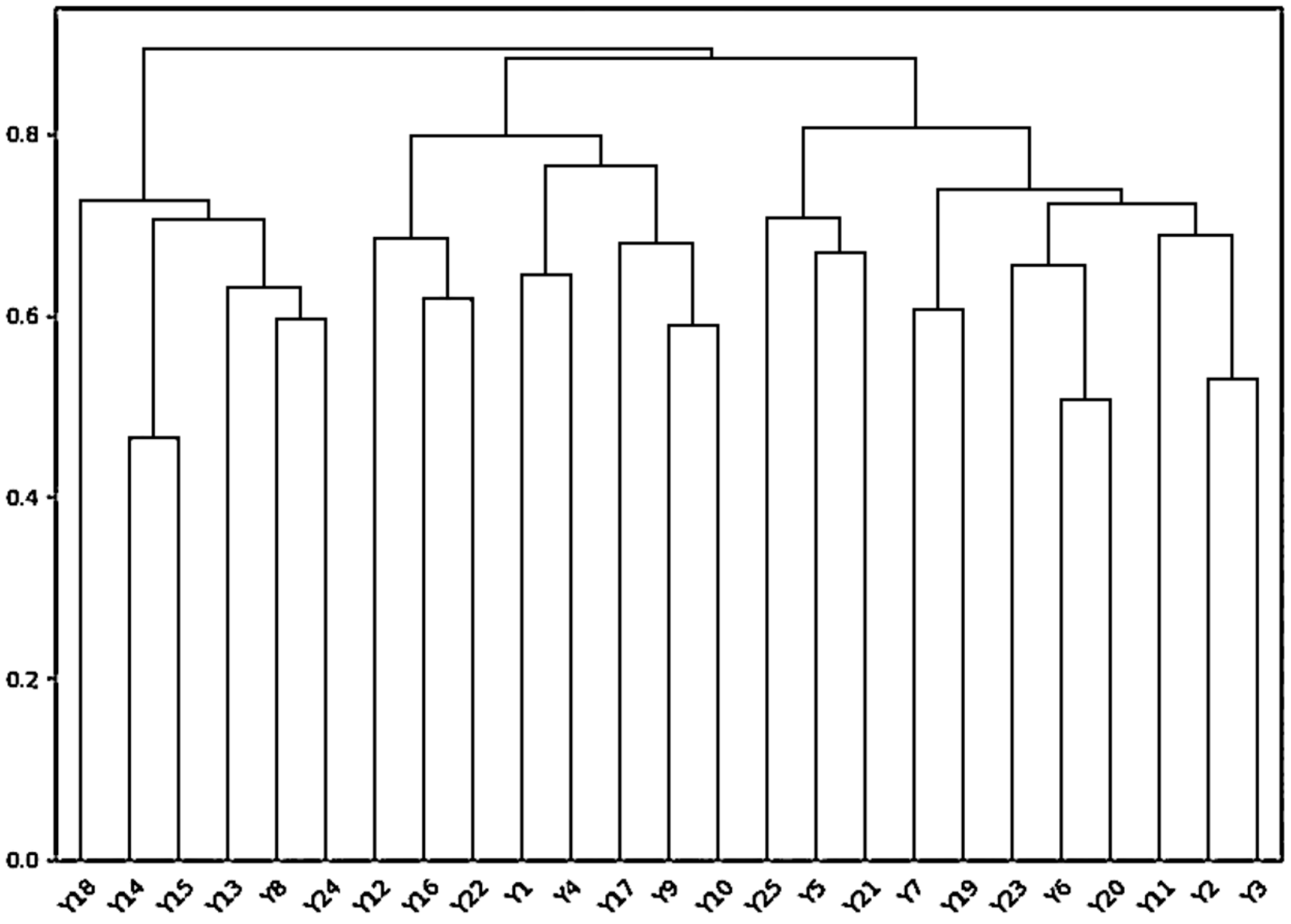
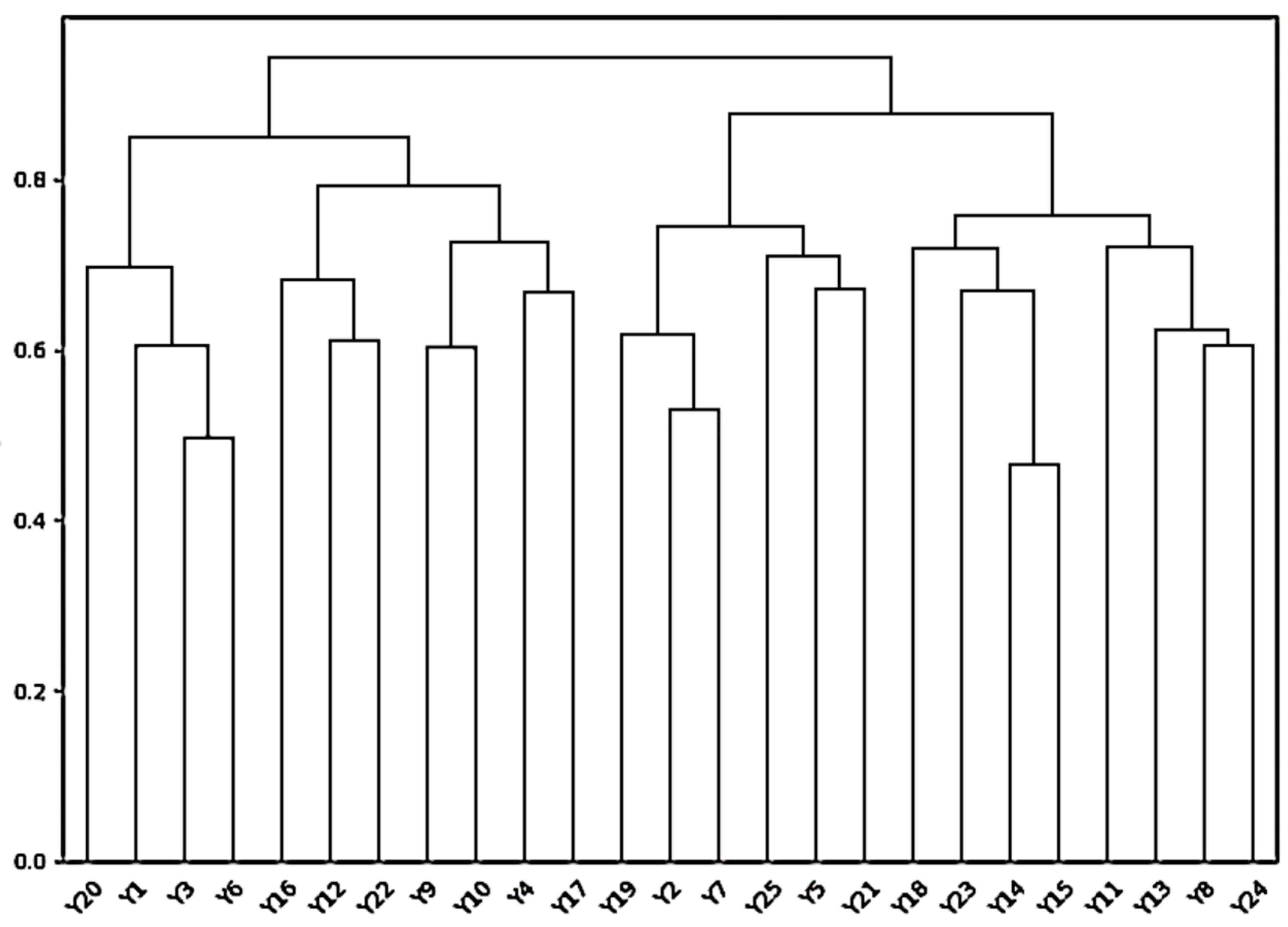
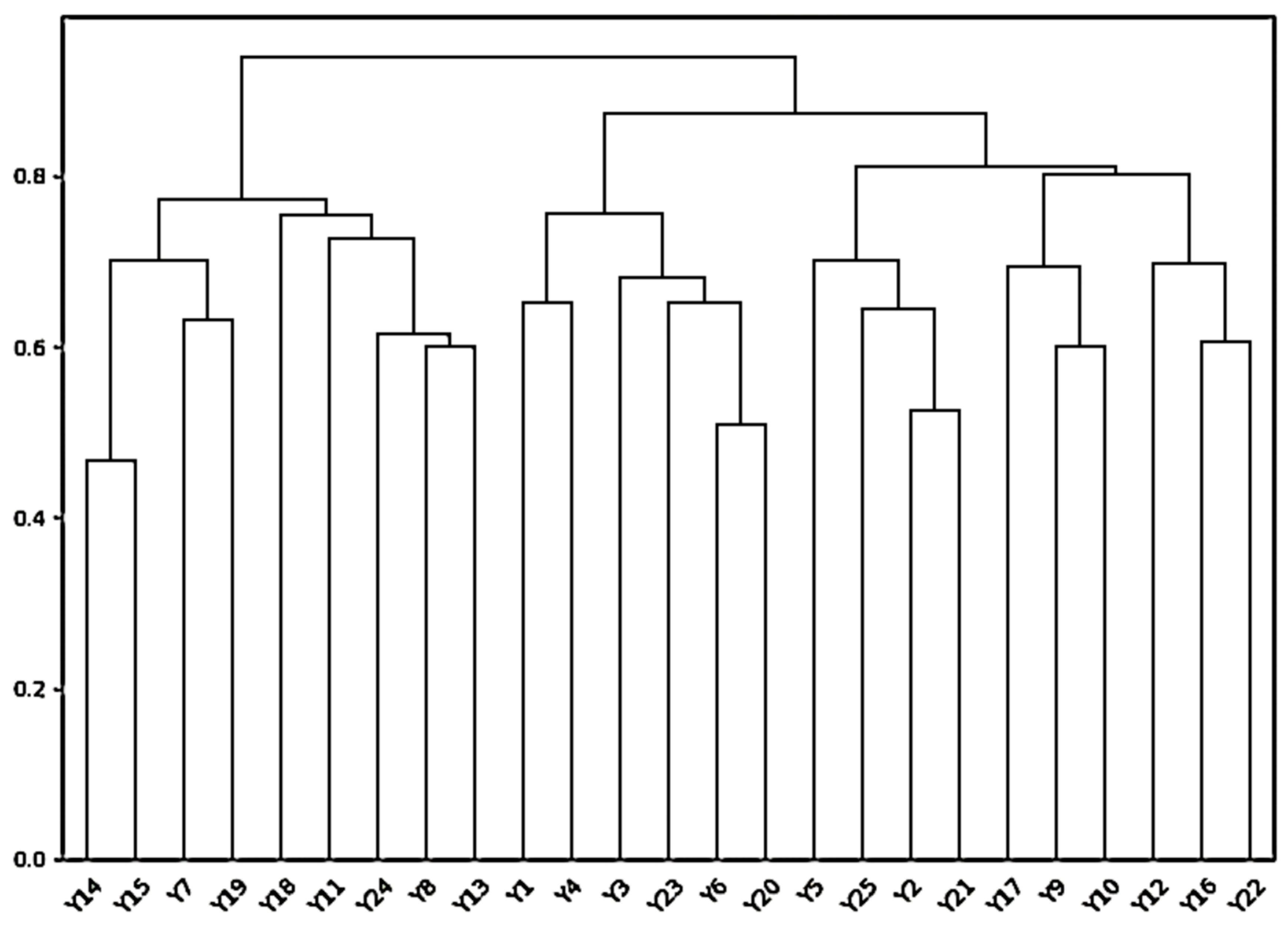
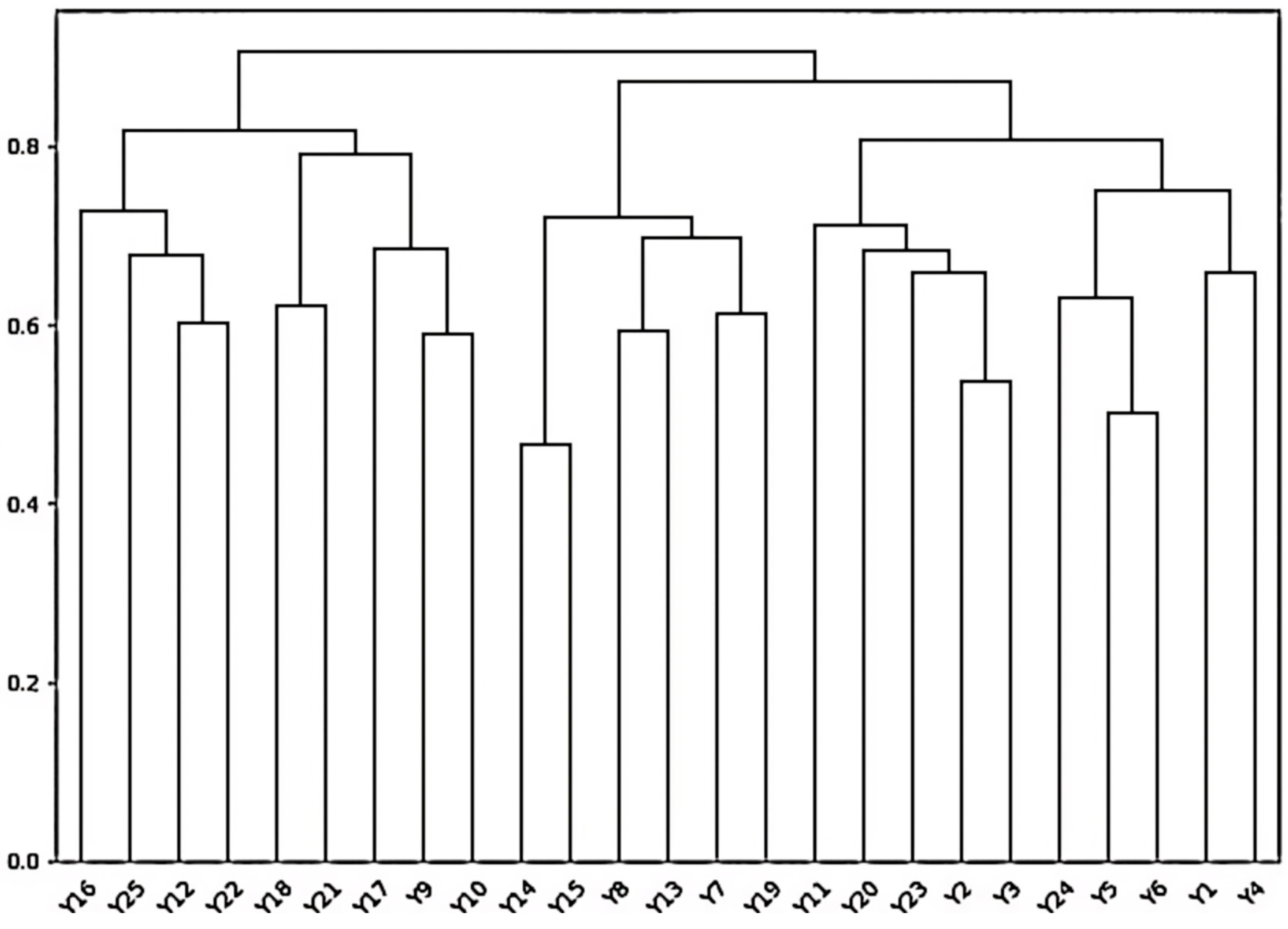
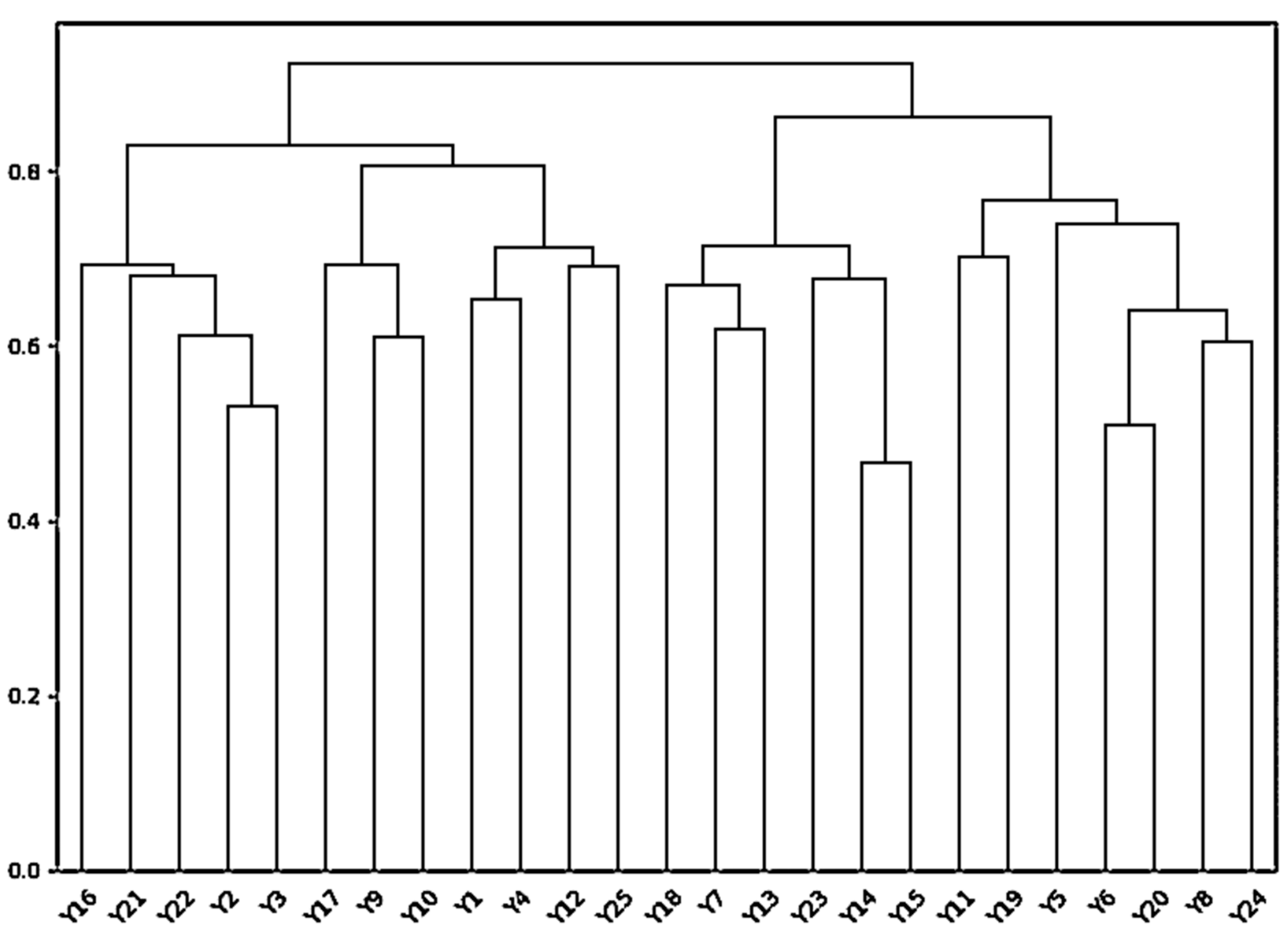
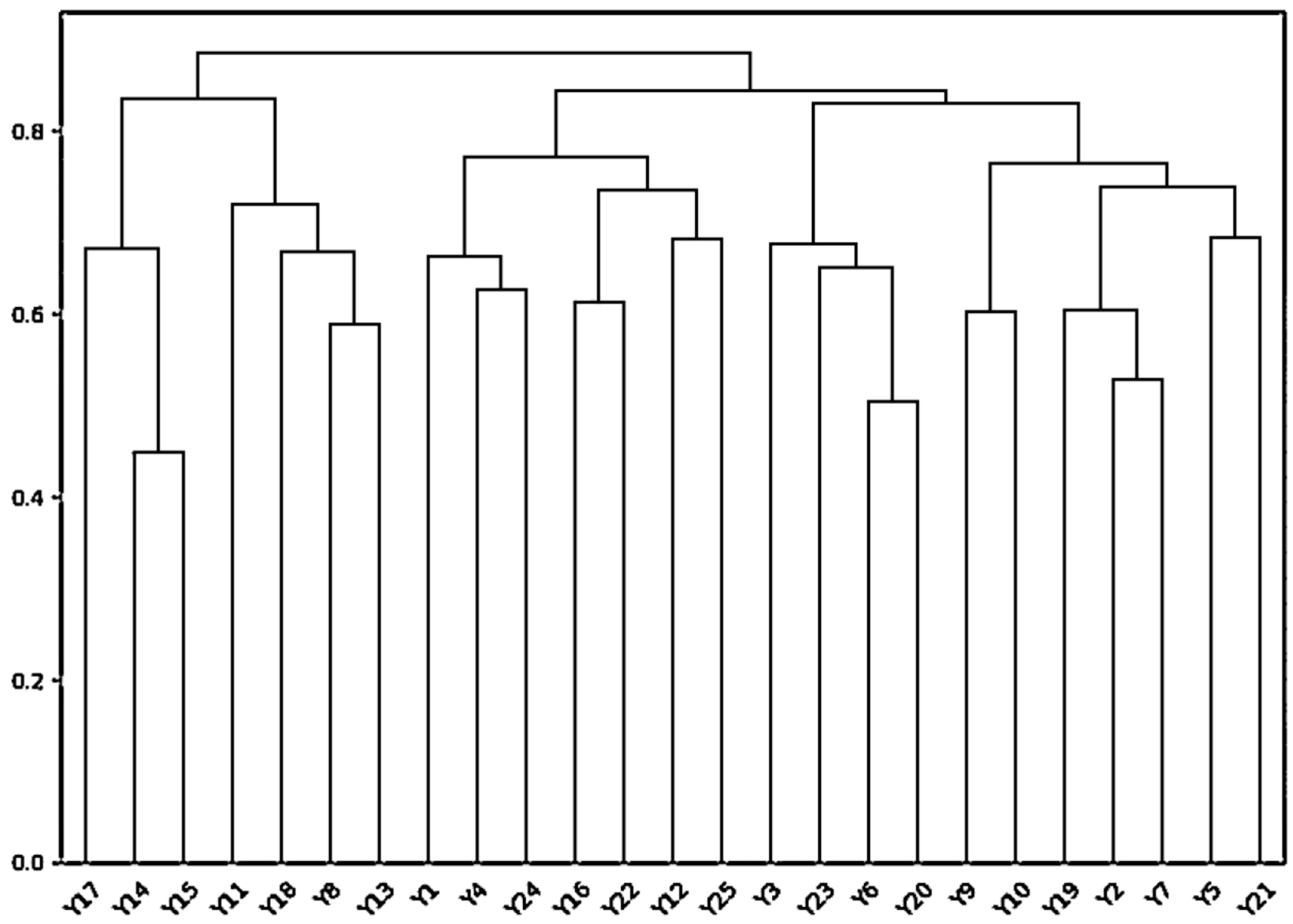
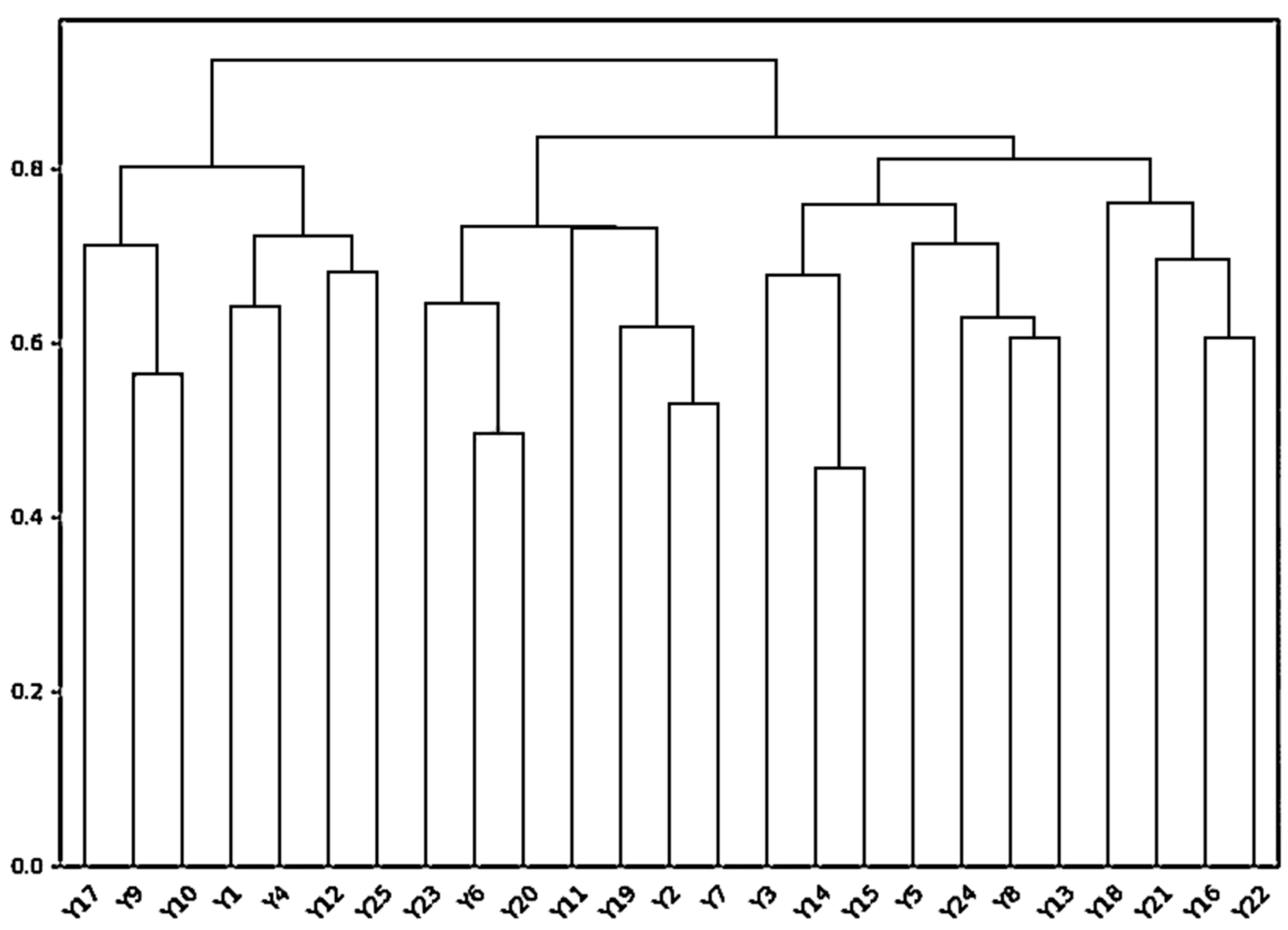
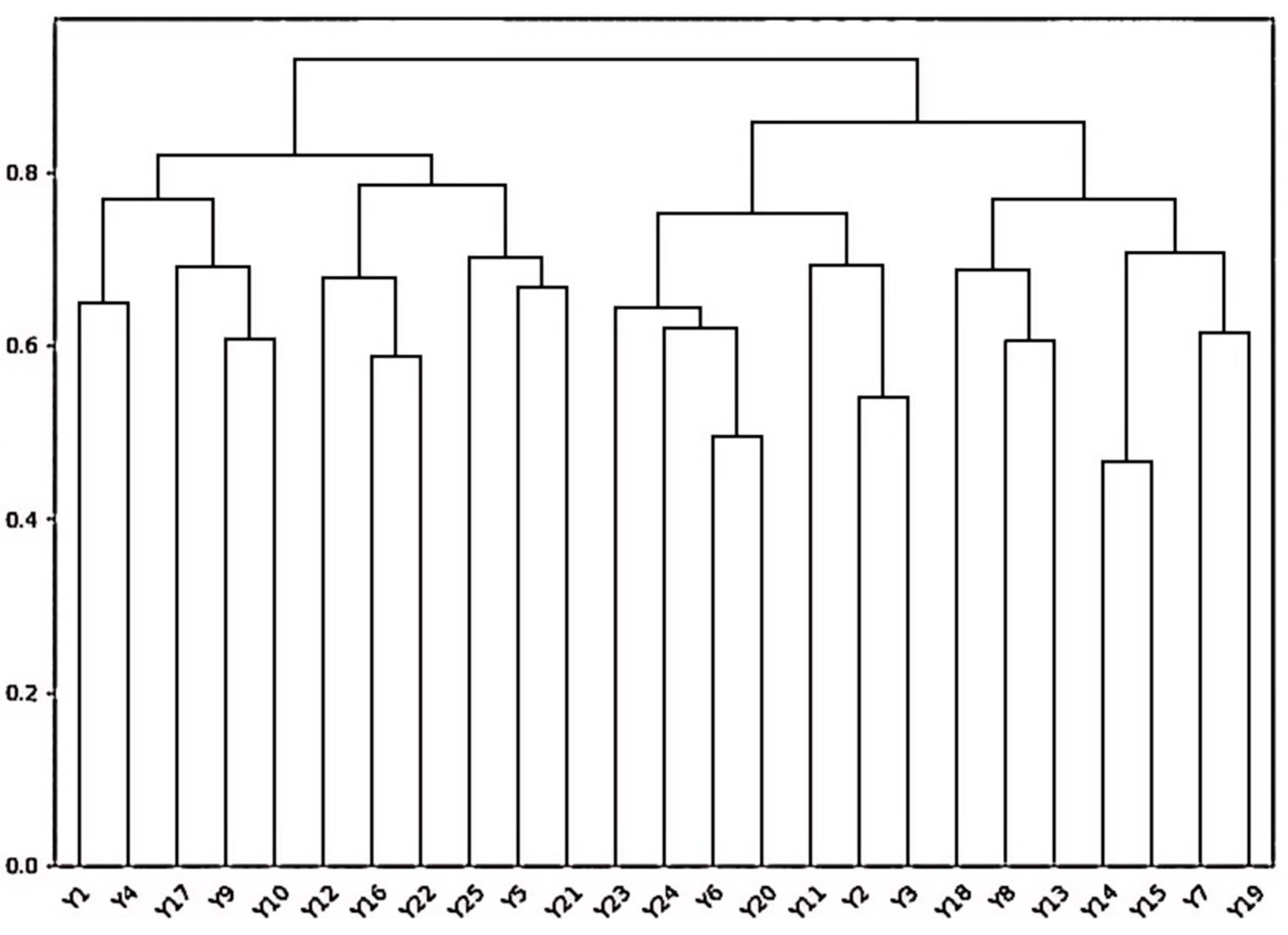
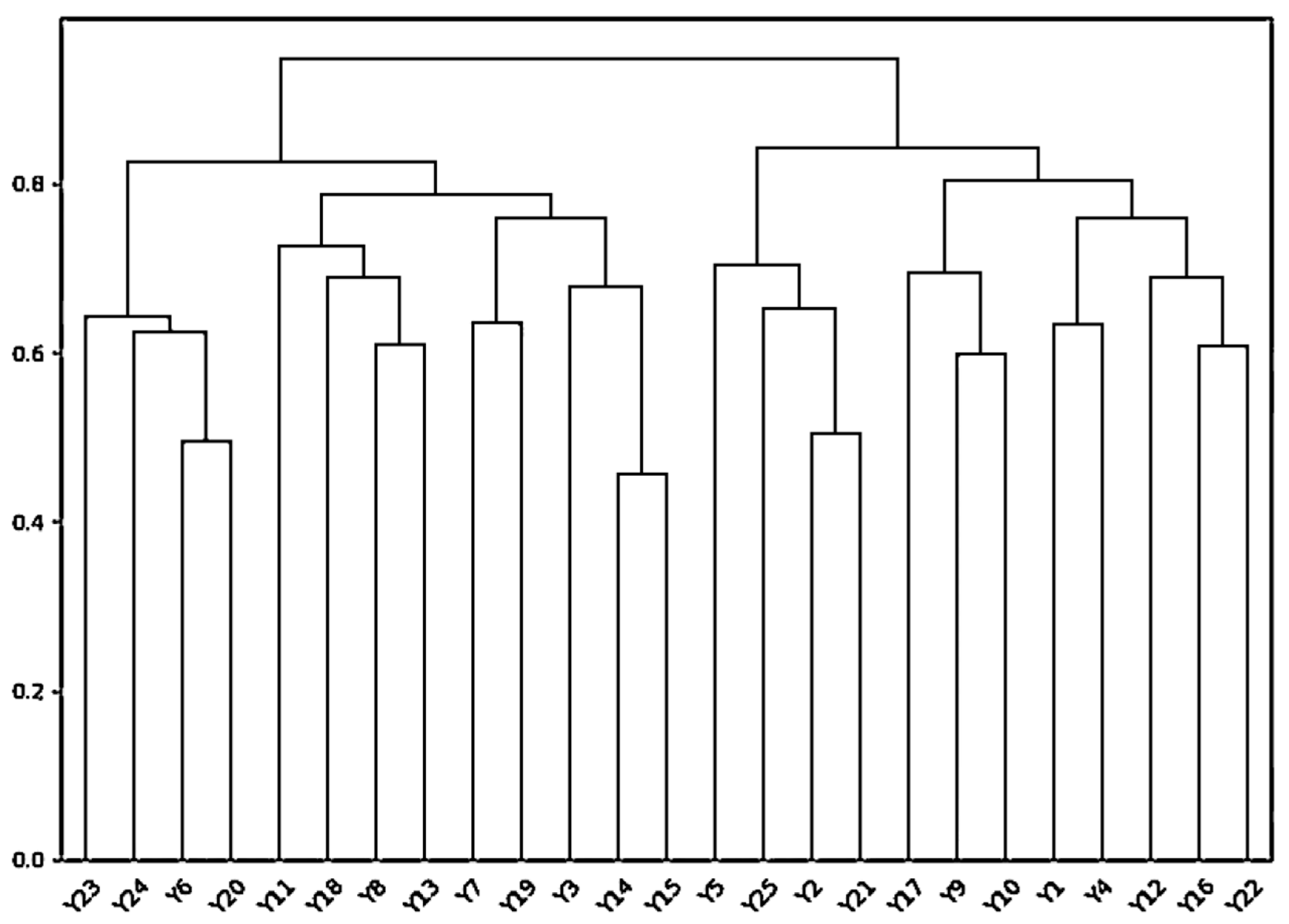

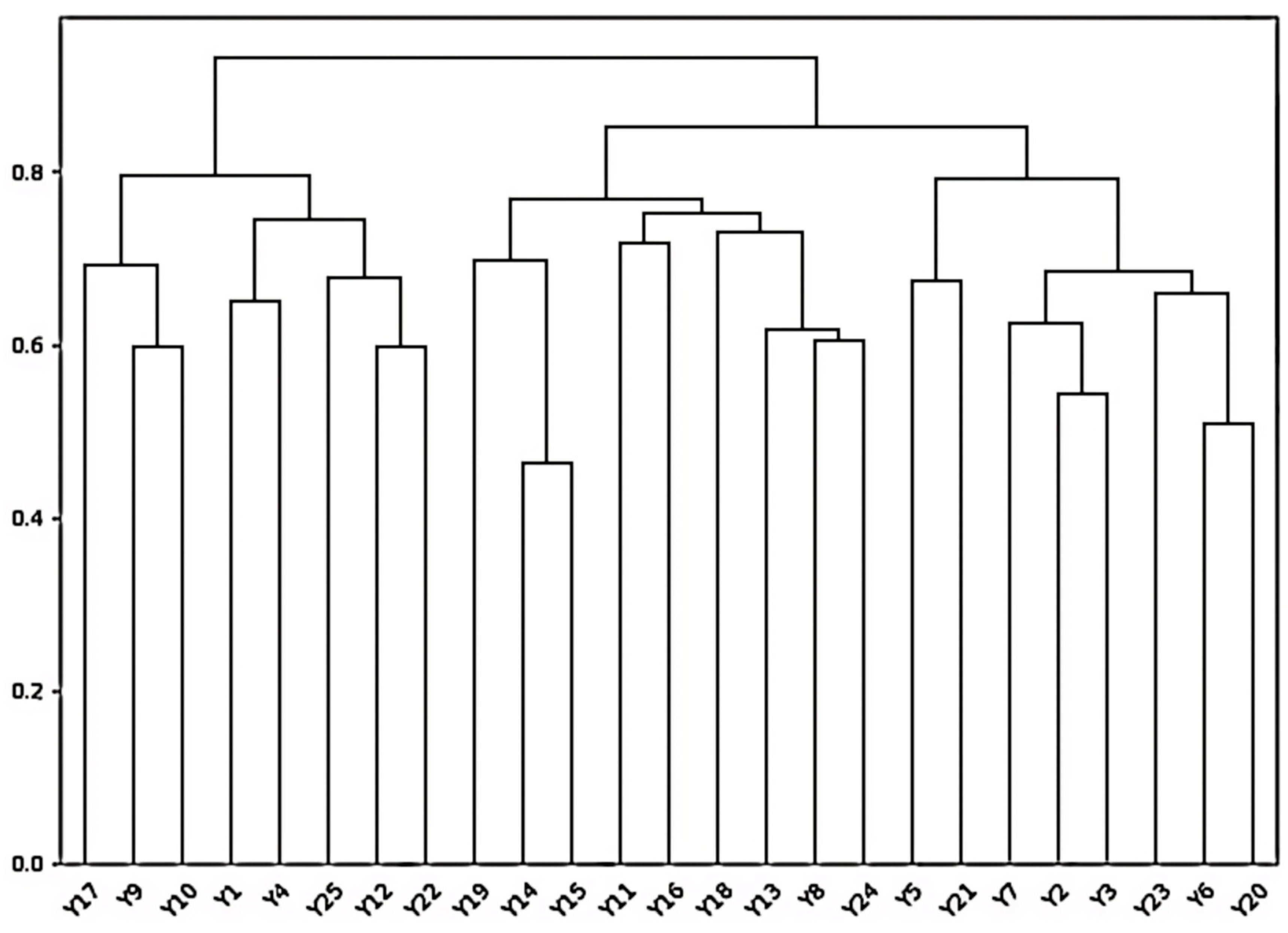
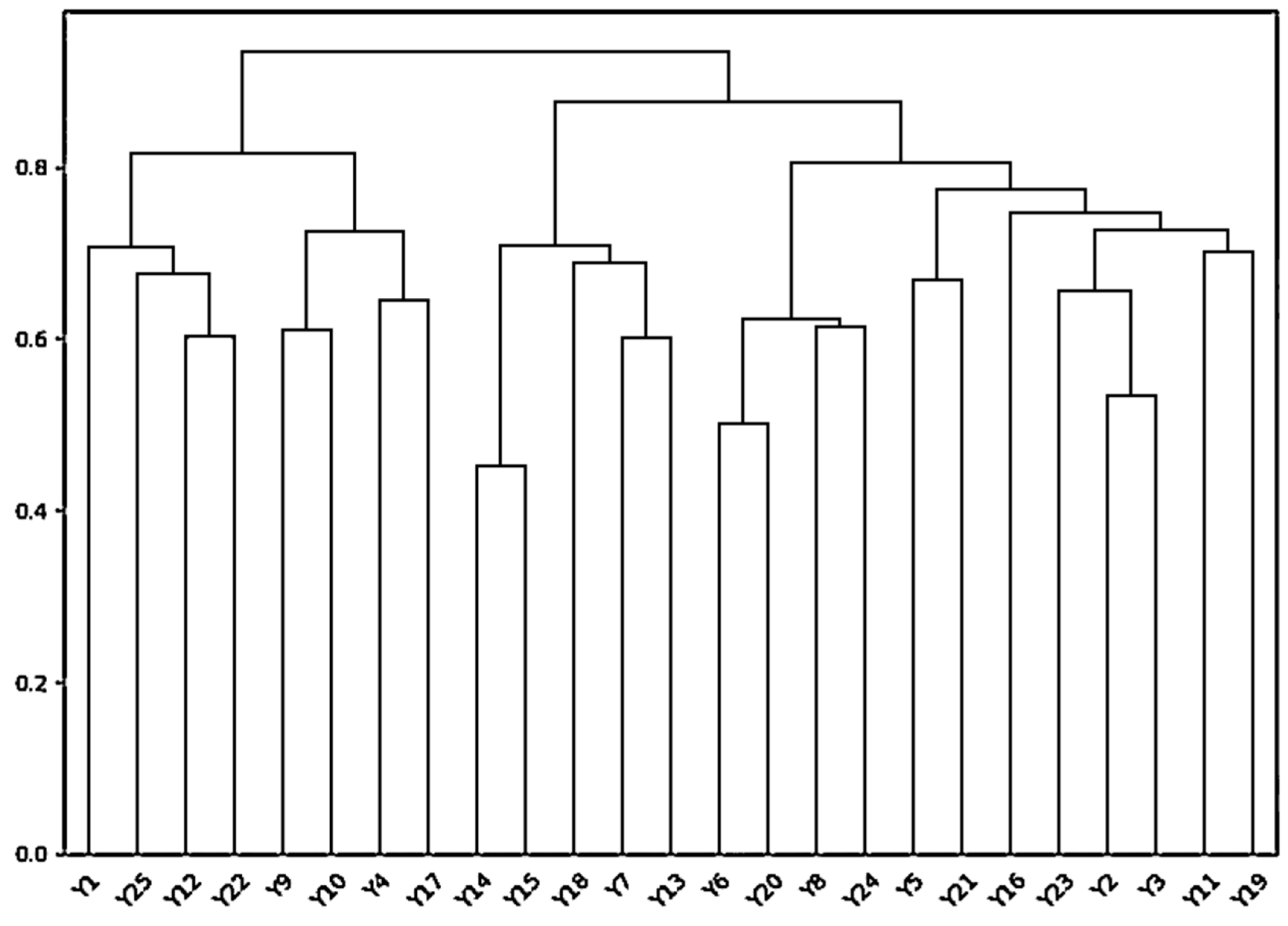

References
- Sarfo, I.; Qiao, J.; Effah, N.A.A.; Djan, M.A.; Puplampu, D.A.; Batame, M.; Ayelazuno, R.A.; Yeboah, E.; Allotey, M.K.; Zhu, X. A Bibliometric Analysis of China’s Rural Revitalization Pradox: Opportunities for Collaboration, Social Innovation and Global Development. Environ. Dev. Sustain. 2024, 26, 1–43. [Google Scholar] [CrossRef]
- State Council of the Central Committee of the Communist Party of China. Opinions of the Central Committee of the Communist Party of China and the State Council on Doing a Good Job in Comprehensively Promoting the Key Work of Rural Revitalisation in 2023; State Council of the Central Committee of the Communist Party of China: Beijing, China, 2023. [Google Scholar]
- Yu, R.; Liang, Z.; Su, X.; Yan, W. An Assessment of Livelihood Vulnerability of Tourism Smallholders in the Upper Reaches of Yihe River, China. Pol. J. Environ. Stud. 2024, 33, 477–490. [Google Scholar] [CrossRef]
- Tang, L.; Yang, M.; Liu, Y.; Zhou, P. Classification, Evolution Trend, and Research Prospect of Rural Multifunction in Metropolitan Suburbs. Trop. Geogr. 2024, 44, 68–78. [Google Scholar]
- Tong, J.; Li, Y.; Yang, Y. System Construction, Tourism Empowerment, and Community Participation: The Sustainable Way of Rural Tourism Development. Sustainability 2024, 16, 422. [Google Scholar] [CrossRef]
- Li, Z.; Xia, J. 30years of rural tourism research:literature review and research prospect. J. Cent. China Norm. Univ. Nat. Sci. Ed. 2024, 58, 1–12. [Google Scholar]
- Gao, R.; Zheng, S. Coupling coordination between agriculture and tourism in the Qinba Mountain area: A case study of Shanyang County, Shanxi Province. Environ. Dev. Sustain. 2024, 26, 1–20. [Google Scholar] [CrossRef]
- Chen, W.; Bin, C.; Tang, C.; Liu, X. Industry-Talentcoupling coordination evaluation and integration development model of rural tourism in ethic regions of Yunnan, Guangxi and Guizhou. J. Cent. China Norm. Univ. Nat. Sci. Ed. 2024, 58, 116–125. [Google Scholar]
- Xue, B.; Li, H.-Q.; Gang, S.; Ren, W.-X.; Wang, Y.-S.; Fang, L.; Li, Y.-J.; Zhao, X.-Y.; Chen, X.; Li, T.-L. Develop the rural ecology in the New Era. Ying Yong Sheng Tai Xue Bao=J. Appl. Ecol. 2024, 35, 268–274. [Google Scholar] [CrossRef]
- Zhang, X.; Zhang, Y.; Chen, H. Research on the development path of resource-based towns under the background of rural revitalizationtaking Chaohu Bantang Hot Spring town as an example. Jiangsu J. Agric. Sci. 2020, 36, 219–226. [Google Scholar]
- Zhou, F.; Zhao, F.; Xu, Q.; Yuan, Y.; Zhang, M. Evaluation and Selection Methods of Tourism Characteristic Town: The Case of Liaoning Province, China. Sustainability 2020, 12, 5372. [Google Scholar] [CrossRef]
- Ren, K.; Wu, T. Analyzing the Evolution of a Rural Construction Community in China from the Perspective of Cultural Landscape. Buildings 2024, 14, 97. [Google Scholar] [CrossRef]
- Zhang, Y.; Liu, B.; Zhao, H.; Lin, W.; Cheng, L.; Wang, X. Analyzing the spatiotemporal pattern of the decoupling degree between carbon metabolism and economic development in village and town units. PLoS ONE 2024, 19, e0296787. [Google Scholar] [CrossRef]
- Ren, T.; Wang, N.; Xiao, H.; Zhou, Z. Efficiency of funding to rural revitalization and regional heterogeneity of technologies in China: Dynamic network nonconvex metafrontiers. Socio-Econ. Plan. Sci. 2024, 92, 101825. [Google Scholar] [CrossRef]
- Sun, Y.; Zhang, B.; Lei, K.; Wu, Y.; Wei, D.; Zhang, B. Assessing rural landscape diversity for management and conservation: A case study in Lichuan, China. Environ. Dev. Sustain. 2024, 26, 1–29. [Google Scholar] [CrossRef]
- Ristic, D.; Vukoicic, D.; Ivanovic, M.; Nikolic, M.; Milentijevic, N.; Mihajlović, L.; Petrović, D. Transformation of Abandoned Railways into Tourist Itineraries/Routes: Model of Revitalization of Marginal Rural Areas. Land 2024, 13, 321. [Google Scholar] [CrossRef]
- Zhang, J.; Wang, S.; Zhao, W.; Liu, Y.; Fu, B. Research progress on the interlinkages between the 17 Sustainable Development Goals and their implication for domestic study. Acta Ecol. Sin. 2019, 39, 8327–8337. [Google Scholar] [CrossRef]
- Ma, Y.; Ai, X. Evaluation of Sustainable Urbanization Development in Jilin Province Based on the 2030 Sustainable Development Goals. Sci. Geogr. Sin. 2019, 39, 487–495. [Google Scholar] [CrossRef]
- Dong, X.; Yang, C.; Liu, X. The Exploration of China New Urbanization Theory. Urban Stud. 2017, 24, 26–34. [Google Scholar] [CrossRef]
- Ao, S.; Zhang, P.; Yu, C.; Li, G.Y.; Wang, C.X. The Theory and Practice of New Urbanization in China. Sci. Geogr. Sin. 2014, 34, 641–647. [Google Scholar] [CrossRef]
- Sun, J.; Xu, X.; Wang, N.; Xie, Y.; Ma, B.; Zhang, J.; Yang, Y.; Li, F.; Liao, J.-L.; Weng, S.-X. Ways and patterns of tourism’s role in poverty alleviation and rural revitalization: Expert discussion on “Tourism for Poverty Alleviation and Rural Revitalization”. J. Nat. Resour. 2021, 36, 2604–2614. [Google Scholar] [CrossRef]
- Zhou, T.; Jiang, G.; Ma, W.; Zhang, R.; Tian, Y.; Zhao, Q.; Tian, Y. A framework for identifying the distribution of revitalization potential of idle rural residential land under rural revitalization. Land Use Policy 2024, 136, 106977. [Google Scholar] [CrossRef]
- Xu, Q.; Zhong, M.; Dong, Y. Digital finance and rural revitalization: Empirical test and mechanism discussion. Technol. Forecast. Soc. Change 2024, 201, 123248. [Google Scholar] [CrossRef]
- Xiong, Z.; Huang, Y.; Yang, L. Rural revitalization in China: Measurement indicators, regional differences and dynamic evolution. Heliyon 2024, 10, e29880. [Google Scholar] [CrossRef] [PubMed]
- Tao, Y.; Wu, Y. An Empirical Study on the Evaluation of the Implementation Effect of the Rural Revitalization Strategy in Chongqing Municipality, China. Iran. J. Sci. Technol.-Trans. Civ. Eng. 2024, 48, 561–576. [Google Scholar] [CrossRef]
- Zhou, C.; Liu, J.; Wan, S.; Zheng, H.; Chen, S. Agricultural insurance and rural revitalization-an empirical analysis based on China’s provincial panel data. Front. Public Health 2023, 11, 1291476. [Google Scholar] [CrossRef] [PubMed]
- Li, B.; Li, X.; Chen, X.; Dou, Y.; Liu, P. Two-wheel driven construction of characteristic tourist towns under the background of new urbanization. Prog. Geogr. 2021, 40, 40–49. [Google Scholar] [CrossRef]
- Li, D.; Zheng, L.; Lin, S.; Yu, X.; Zhang, S.; Wang, F. Study on the Formation Mechanism and Path Optimization of Agricultural Characteristic Towns Case Analysis Based on Chengdu Model. China Soft Sci. 2018, 5, 79–90. [Google Scholar]
- Zhan, S.; Song, X. Study on the Development Mode and Spatial Distribution Characterristics of Characteristics Towns in ShaAnXi Province. J. China Agric. Resour. Reg. Plan. 2021, 42, 16–22. [Google Scholar]
- Chen, C.; Qian, S. Study on Ecological Restoration of Mining Relics in NanJing TangShan Healthy Pension Characteristic Town. Ind. Constr. 2021, 51, 87–92, 153. [Google Scholar]
- Liu, Y.; Hou, H.B.; Zhou, M. Study on Ecological Carrying Capacity of Characteristic Town. Fresen Environ. Bull 2019, 28, 3395–3400. [Google Scholar]
- Liao, Z.; Zhang, L. Spatial Distribution Characteristics and Accessibility Analysis of Characteristic Towns in Guangdong Province Based on Ripley’s K Function. J. Math. 2022, 2022, 1–14. [Google Scholar] [CrossRef]
- Ling, D.Z.; Bin, H.C.; Juan, X.J. Spatiotemporal Analysis of Development Efficiency of Characteristic Town In China Under the Resource and Enviroment Restrictions. J. Environ. Prot. Ecol. 2021, 22, 362–377. [Google Scholar]
- Lin, S.; Tian, P.; Li, D. Study on the Evaluation and Promotion of Agricultural Characteristic Towns’ Competitiveness:Case of 30 Towns in Sichuan Province. J. Sichuan Agric. Univ. 2020, 38, 764–774. [Google Scholar]
- GB/T 41410-2022; Chinese National Institute of Standardization. State Administration for Market Regulation; National Standardization Administration Committee: Beijing, China, 2022.
- Wang, H.; Zhao, L.; Yan, C.; Gong, Q. Research on the Construction of Evaluation Index System of Featured Town Maturity Based on Ordinal Relationship Analysis Method. Urban Dev. Res. 2021, 28, 26–29. [Google Scholar] [CrossRef]
- Wu, Y.; Chen, Q.; Zheng, X. Indicator System and Evaluation Method for the Development Level of Characteristic Towns. Planner 2016, 7, 123–127. [Google Scholar] [CrossRef]
- Wen, Y.; Jin, P. Construction of Core Competitiveness and Evaluation Model of Characteristic Towns. Ecol. Econ. 2017, 33, 85–89. [Google Scholar]
- Wang, C.; Jia, S. Characteristics Index System and Evaluation of Chinese Characteristic Towns. Nanjing Soc. Sci. 2019, 2, 79–86. [Google Scholar]
- Tian, X.; Zhao, X. Research on Evaluation Index System of Development Level of Sports Characteristic Towns. J. Chengdu Sport Univ. 2018, 44, 45–52. [Google Scholar] [CrossRef]
- Zhang, T.; Li, M.; Xu, Y. Construction and Empirical Research of Evaluation Index System for Rural Revitalization. Manag. World 2018, 8, 99–105. [Google Scholar] [CrossRef]
- Zhao, H. Research on Social Benefits Evaluation of Characteristic Town Projects in China Based on SEM. Master’s Thesis, Shandong Jianzhu University, Jinan, China, 2017; pp. 21–34. [Google Scholar]

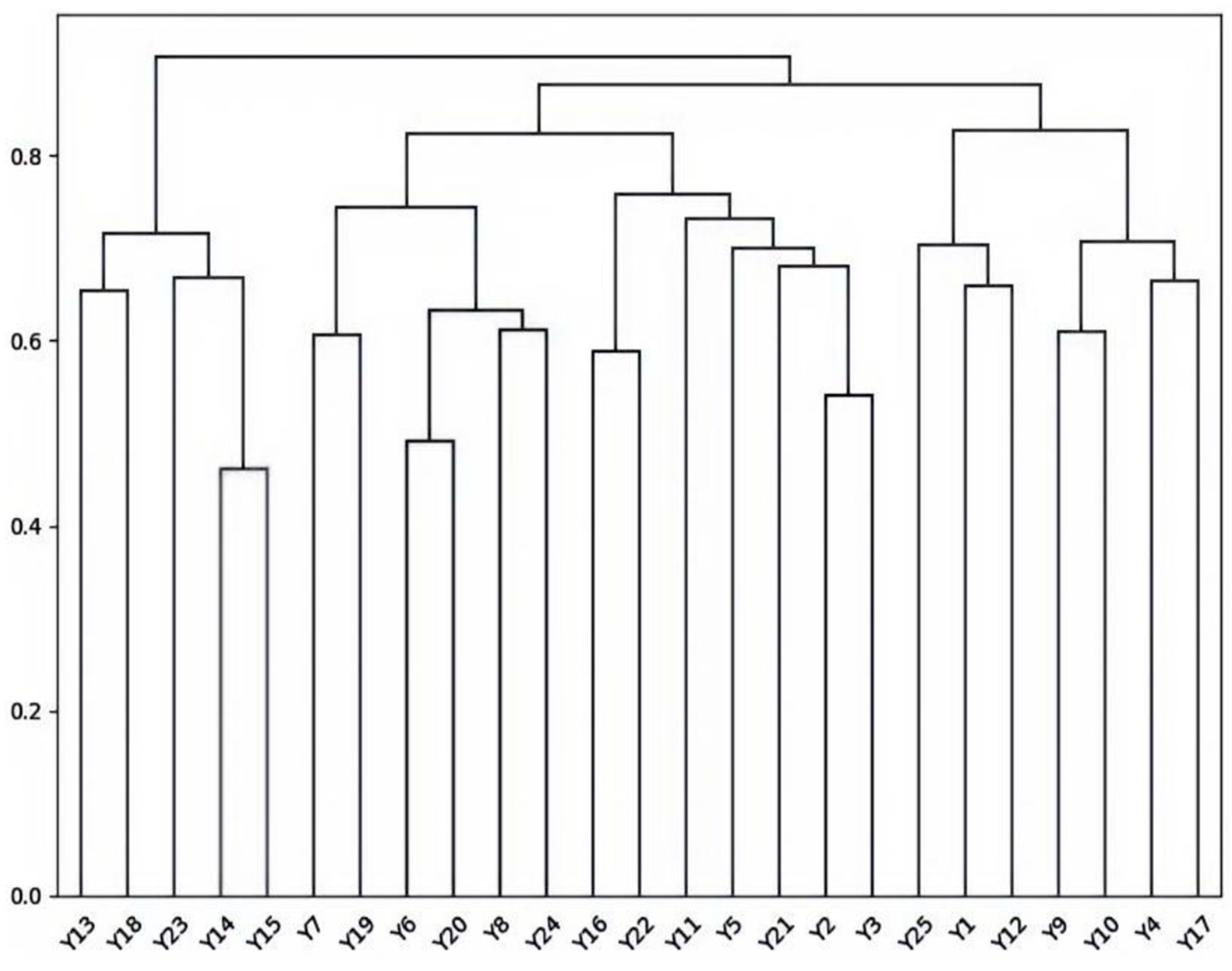
| Evaluation Index System Name | Composition Elements | Scholars (Time) |
|---|---|---|
| Indicator System for Evaluating the Development Level of Distinctive Town Construction | Primary indicators include the development foundation, industrial resources, economic benefits, ecological environment, and policy support, with 20 secondary indicators. | Yanbing Chen et al., 2022 [35] |
| Characteristic town maturity evaluation index system | Includes 7 primary, 21 secondary, and 49 tertiary indicators | Wang Hong et al., 2021 [36] |
| Indicator System for Performance Evaluation of Distinctive Town Development | Four criteria layers, including the industrial dimension, functional dimension, morphological dimension, and institutional dimension, with 37 indicator layers. | Yizhou Wu et al., 2016 [37] |
| Indicator System for Core Competitiveness of Distinctive Towns | Five core competencies: environmental resource strength, infrastructure strength, capital resource strength, industrial development strength, government support strength; 18 secondary indicators; and 32 tertiary indicators. | Wen Yan et al., 2018 [38] |
| Characteristic index system of characteristic towns | Including 9 primary indicators and 18 secondary indicators. | Changlong Wang et al., 2019 [39] |
| Assessment index system for characteristic sports towns in China | Three criteria layers: basic information dimension, characteristic industry dimension, public service dimension; twelve element layers. | Xueli Tian et al., 2018 [40] |
| Rural Revitalization Evaluation Index system | Five secondary indicators: thriving industries, livable ecology, civilized rural customs, effective governance, prosperous livelihoods; fifteen tertiary indicators; forty-four quaternary indicators. | Zhang Ting et al., 2018 [41] |
| Social benefit evaluation index system for characteristic towns | Five latent variables: social and economic development, social livelihood development, ecological environmental impact, infrastructure construction, relevant institutional construction; twenty-eight observed variables. | Haiyang Zhao et al., 2017 [42] |
| Criteria Layer | Indicator Layer | Unit | Nature of Indicators |
|---|---|---|---|
| Thriving industries | industrial contribution rate | % | + |
| industrial characteristics and innovation | % | + | |
| industrial scale and concentration | % | + | |
| industrial driving force | % | + | |
| level of industrial chain competitiveness | % | + | |
| Livable ecology | visual effect of urban townscape | % | + |
| comprehensive management of environmental pollution | % | + | |
| efficient utilization of natural resources | % | + | |
| green coverage rate of the town’s vegetation | % | + | |
| level of completeness of public infrastructure | % | + | |
| Civilized rural customs | cultural heritage and ideological transformation | % | + |
| level of public participation | % | + | |
| tourism appeal | % | + | |
| development and utilization of cultural resources | % | + | |
| contribution of population quality and education level | % | + | |
| Effective governance | construction of relevant institutions in the town | % | + |
| talent introduction | % | + | |
| degree of rational sharing of public resources | % | + | |
| level of completeness of public services | % | + | |
| Prosperous livelihoods | income distribution effect | % | + |
| degree of improvement in residents’ living standards | % | + | |
| employment absorption rate of residents | % | + |
| Norm | Expert Scores | ||||||||||||||||||||||||
|---|---|---|---|---|---|---|---|---|---|---|---|---|---|---|---|---|---|---|---|---|---|---|---|---|---|
| 90 | 78 | 90 | 90 | 89 | 84 | 90 | 90 | 98 | 90 | 88 | 90 | 80 | 89 | 75 | 90 | 88 | 90 | 90 | 89 | 93 | 90 | 90 | 98 | 89 | |
| 88 | 79 | 95 | 91 | 86 | 78 | 88 | 89 | 96 | 88 | 89 | 98 | 81 | 86 | 78 | 88 | 89 | 90 | 91 | 86 | 88 | 88 | 89 | 96 | 90 | |
| 85 | 86 | 91 | 89 | 89 | 79 | 85 | 87 | 92 | 92 | 86 | 91 | 87 | 89 | 79 | 92 | 86 | 91 | 92 | 89 | 95 | 85 | 87 | 92 | 94 | |
| 92 | 92 | 94 | 94 | 88 | 88 | 92 | 88 | 93 | 95 | 92 | 94 | 89 | 88 | 88 | 95 | 92 | 94 | 94 | 88 | 92 | 92 | 88 | 93 | 92 | |
| 96 | 94 | 92 | 93 | 96 | 82 | 91 | 86 | 91 | 96 | 94 | 92 | 83 | 96 | 82 | 96 | 94 | 92 | 93 | 96 | 91 | 95 | 86 | 91 | 93 | |
| 83 | 76 | 90 | 69 | 77 | 67 | 90 | 84 | 74 | 86 | 58 | 90 | 79 | 83 | 64 | 72 | 60 | 90 | 89 | 65 | 93 | 90 | 84 | 94 | 78 | |
| 90 | 88 | 93 | 92 | 94 | 65 | 83 | 89 | 93 | 90 | 95 | 93 | 92 | 94 | 65 | 90 | 95 | 93 | 92 | 94 | 93 | 83 | 89 | 93 | 91 | |
| 91 | 77 | 89 | 88 | 93 | 67 | 90 | 88 | 90 | 91 | 97 | 89 | 78 | 93 | 67 | 91 | 97 | 89 | 88 | 93 | 92 | 81 | 83 | 88 | 90 | |
| 84 | 65 | 79 | 86 | 91 | 66 | 88 | 89 | 90 | 92 | 91 | 89 | 86 | 91 | 55 | 92 | 91 | 89 | 86 | 91 | 88 | 86 | 92 | 89 | 93 | |
| 90 | 82 | 88 | 92 | 90 | 64 | 92 | 86 | 91 | 90 | 90 | 88 | 92 | 90 | 64 | 90 | 90 | 88 | 92 | 90 | 91 | 72 | 94 | 84 | 88 | |
| 89 | 74 | 62 | 73 | 87 | 60 | 70 | 92 | 83 | 89 | 90 | 86 | 83 | 92 | 60 | 89 | 77 | 86 | 83 | 74 | 85 | 80 | 93 | 86 | 90 | |
| 87 | 88 | 88 | 90 | 90 | 71 | 93 | 90 | 90 | 87 | 92 | 81 | 88 | 93 | 71 | 87 | 92 | 81 | 88 | 93 | 88 | 91 | 91 | 87 | 77 | |
| 92 | 79 | 89 | 85 | 71 | 75 | 88 | 88 | 89 | 88 | 90 | 90 | 89 | 94 | 70 | 88 | 90 | 68 | 89 | 94 | 86 | 92 | 90 | 76 | 89 | |
| 96 | 79 | 86 | 91 | 92 | 66 | 95 | 85 | 87 | 96 | 91 | 93 | 92 | 95 | 66 | 96 | 91 | 93 | 92 | 95 | 87 | 86 | 89 | 90 | 90 | |
| 93 | 69 | 92 | 94 | 94 | 71 | 72 | 92 | 88 | 93 | 93 | 92 | 92 | 65 | 71 | 93 | 93 | 92 | 67 | 90 | 88 | 75 | 87 | 69 | 91 | |
| 91 | 80 | 94 | 92 | 93 | 78 | 76 | 91 | 74 | 91 | 65 | 88 | 86 | 92 | 78 | 90 | 88 | 90 | 90 | 89 | 93 | 96 | 90 | 98 | 89 | |
| 94 | 75 | 96 | 90 | 89 | 98 | 93 | 75 | 84 | 94 | 90 | 86 | 82 | 94 | 58 | 88 | 89 | 90 | 91 | 86 | 88 | 88 | 89 | 96 | 90 | |
| 91 | 69 | 95 | 73 | 92 | 80 | 83 | 83 | 89 | 93 | 91 | 96 | 65 | 93 | 80 | 92 | 86 | 91 | 72 | 89 | 95 | 85 | 87 | 92 | 94 | |
| 90 | 77 | 97 | 89 | 88 | 75 | 92 | 81 | 83 | 88 | 90 | 91 | 91 | 91 | 75 | 95 | 92 | 94 | 94 | 88 | 92 | 92 | 88 | 73 | 92 | |
| 86 | 74 | 91 | 89 | 86 | 70 | 88 | 86 | 92 | 89 | 93 | 92 | 92 | 90 | 70 | 96 | 94 | 92 | 93 | 96 | 84 | 91 | 86 | 91 | 93 | |
| 93 | 81 | 90 | 78 | 92 | 80 | 91 | 82 | 94 | 84 | 88 | 93 | 65 | 89 | 80 | 76 | 96 | 90 | 89 | 95 | 93 | 90 | 84 | 94 | 90 | |
| 95 | 82 | 90 | 86 | 83 | 76 | 85 | 80 | 93 | 86 | 86 | 94 | 89 | 87 | 76 | 80 | 95 | 93 | 92 | 94 | 93 | 83 | 89 | 93 | 91 | |
| Classification | 2 | 3 | 4 | 5 |
|---|---|---|---|---|
| 0.6557 | 0.6557 | 0.7128 | 0.8024 | |
| 4.3037 | 4.3037 | 4.9350 | 5.6400 | |
| 2.6143 | 2.6143 | 2.7401 | 2.8661 | |
| 0.6462 | 0.6462 | 0.8011 | 0.9678 |
| Indicators | Optimal Clustering |
|---|---|
| All indicators | {y1}, {y2}, {y3}, {y4}, {y5}, {y6}, {y7}, {y8}, {y9}, {y10}, {y11}, {y12}, {y13}, {y14’, ‘y15}, {y16}, {y17}, {y18}, {y19}, {y20}, {y21}, {y22}, {y23}, {y24}, {y25} |
| B-X1 | {y1}, {y2}, {y3}, {y4}, {y5}, {y6’, ‘y20}, {y7}, {y8}, {y9}, {y10}, {y11}, {y12}, {y13}, {y14’, ‘y15}, {y16}, {y17}, {y18}, {y19}, {y21}, {y22}, {y23}, {y24}, {y25} |
| B-X2 | {y1}, {y2}, {y3}, {y4}, {y5}, {y6’, ‘y20}, {y7}, {y8}, {y9}, {y10}, {y11}, {y12}, {y13}, {y14’, ‘y15}, {y16}, {y17}, {y18}, {y19}, {y21}, {y22}, {y23}, {y24}, {y25} |
| B-X3 | {y1}, {y2}, {y3}, {y4}, {y5}, {y6}, {y7}, {y8}, {y9}, {y10}, {y11}, {y12}, {y13}, {y14’, ‘y15}, {y16}, {y17}, {y18}, {y19}, {y20}, {y21}, {y22}, {y23}, {y24}, {y25} |
| B-X4 | {y1}, {y2}, {y3}, {y4}, {y5}, {y6}, {y7}, {y8}, {y9}, {y10}, {y11}, {y12}, {y13}, {y14}, {y15’, ‘y20}, {y16}, {y17}, {y18}, {y19}, {y21}, {y22}, {y23}, {y24}, {y25} |
| B-X5 | {y1}, {y2}, {y3}, {y4}, {y5}, {y6}, {y7}, {y8}, {y9}, {y10}, {y11}, {y12}, {y13}, {y14’, ‘y15}, {y16}, {y17}, {y18}, {y19}, {y20}, {y21}, {y22}, {y23}, {y24}, {y25} |
| B-X6 | {y1}, {y2}, {y3}, {y4}, {y5}, {y6’, ‘y14}, {y7}, {y8}, {y9}, {y10}, {y11}, {y12}, {y13}, {y15’, ‘y20}, {y16}, {y17}, {y18}, {y19}, {y21}, {y22}, {y23}, {y24}, {y25} |
| B-X7 | {y1}, {y2}, {y3}, {y4}, {y5}, {y6}, {y7}, {y8}, {y9}, {y10}, {y11}, {y12}, {y13}, {y14’, ‘y15}, {y16}, {y17}, {y18}, {y19}, {y20}, {y21}, {y22}, {y23}, {y24}, {y25} |
| B-X8 | {y1}, {y2}, {y3}, {y4}, {y5}, {y6}, {y7}, {y8}, {y9}, {y10}, {y11}, {y12}, {y13}, {y14’, ‘y15}, {y16}, {y17}, {y18}, {y19}, {y20}, {y21}, {y22}, {y23}, {y24}, {y25} |
| B-X9 | {y1}, {y2}, {y3}, {y4}, {y5}, {y6}, {y7}, {y8}, {y9}, {y10}, {y11}, {y12}, {y13}, {y14’, ‘y15}, {y16}, {y17}, {y18}, {y19}, {y20}, {y21}, {y22}, {y23}, {y24}, {y25} |
| B-X10 | {y1}, {y2}, {y3}, {y4}, {y5}, {y6}, {y7}, {y8}, {y9}, {y10}, {y11}, {y12}, {y13}, {y14’, ‘y15}, {y16}, {y17}, {y18}, {y19}, {y20}, {y21}, {y22}, {y23}, {y24}, {y25} |
| B-X11 | {y1}, {y2}, {y3’, ‘y6}, {y4}, {y5}, {y7}, {y8}, {y9}, {y10}, {y11}, {y12}, {y13}, {y14’, ‘y15}, {y16}, {y17}, {y18}, {y19}, {y20}, {y21}, {y22}, {y23}, {y24}, {y25} |
| B-X12 | {y1}, {y2}, {y3}, {y4}, {y5}, {y6}, {y7}, {y8}, {y9}, {y10}, {y11}, {y12}, {y13}, {y14’, ‘y15}, {y16}, {y17}, {y18}, {y19}, {y20}, {y21}, {y22}, {y23}, {y24}, {y25} |
| B-X13 | {y1}, {y2}, {y3}, {y4}, {y5}, {y6}, {y7}, {y8}, {y9}, {y10}, {y11}, {y12}, {y13}, {y14’, ‘y15}, {y16}, {y17}, {y18}, {y19}, {y20}, {y21}, {y22}, {y23}, {y24}, {y25} |
| B-X14 | {y1}, {y2}, {y3}, {y4}, {y5}, {y6}, {y7}, {y8}, {y9}, {y10}, {y11}, {y12}, {y13}, {y14’, ‘y15}, {y16}, {y17}, {y18}, {y19}, {y20}, {y21}, {y22}, {y23}, {y24}, {y25} |
| B-X15 | {y1}, {y2}, {y3}, {y4}, {y5}, {y6}, {y7}, {y8}, {y9}, {y10}, {y11}, {y12}, {y13}, {y14’, ‘y15}, {y16}, {y17}, {y18}, {y19}, {y20}, {y21}, {y22}, {y23}, {y24}, {y25} |
| B-X16 | {y1}, {y2}, {y3}, {y4}, {y5}, {y6’, ‘y20}, {y7}, {y8}, {y9}, {y10}, {y11}, {y12}, {y13}, {y14’, ‘y15}, {y16}, {y17}, {y18}, {y19}, {y21}, {y22}, {y23}, {y24}, {y25} |
| B-X17 | {y1}, {y2}, {y3}, {y4}, {y5}, {y6’, ‘y20}, {y7}, {y8}, {y9}, {y10}, {y11}, {y12}, {y13}, {y14’, ‘y15}, {y16}, {y17}, {y18}, {y19}, {y21}, {y22}, {y23}, {y24}, {y25} |
| B-X18 | {y1}, {y2}, {y3}, {y4}, {y5}, {y6’, ‘y20}, {y7}, {y8}, {y9}, {y10}, {y11}, {y12}, {y13}, {y14’, ‘y15}, {y16}, {y17}, {y18}, {y19}, {y21}, {y22}, {y23}, {y24}, {y25} |
| B-X19 | {y1}, {y2}, {y3}, {y4}, {y5}, {y6}, {y7}, {y8}, {y9}, {y10}, {y11}, {y12}, {y13}, {y14’, ‘y15}, {y16}, {y17}, {y18}, {y19}, {y20}, {y21}, {y22}, {y23}, {y24}, {y25} |
| B-X20 | {y1}, {y2}, {y3}, {y4}, {y5}, {y6}, {y7}, {y8}, {y9}, {y10}, {y11}, {y12}, {y13}, {y14’, ‘y15}, {y16}, {y17}, {y18}, {y19}, {y20}, {y21}, {y22}, {y23}, {y24}, {y25} |
| B-X21 | {y1}, {y2}, {y3}, {y4}, {y5}, {y6}, {y7}, {y8}, {y9}, {y10}, {y11}, {y12}, {y13}, {y14’, ‘y15}, {y16}, {y17}, {y18}, {y19}, {y20}, {y21}, {y22}, {y23}, {y24}, {y25} |
| B-X22 | {y1}, {y2}, {y3}, {y4}, {y5}, {y6}, {y7}, {y8}, {y9}, {y10}, {y11}, {y12}, {y13}, {y14’, ‘y15}, {y16}, {y17}, {y18}, {y19}, {y20}, {y21}, {y22}, {y23}, {y24}, {y25} |
| Norm | Rankings | |||
|---|---|---|---|---|
| Industry contribution rate (X1) | 0.5843 | 0.0430 | 0.2637 | 8 |
| industrial characteristics and innovativeness (X2) | 0.6180 | 0.0455 | 0.3318 | 7 |
| industrial driving force (X4) | 0.5353 | 0.0394 | 0.6043 | 3 |
| town visual appearance effect (X6) | 0.5830 | 0.0429 | 0.6083 | 2 |
| cultural heritage and ideological change (X11) | 0.6120 | 0.0450 | 0.5427 | 5 |
| town-related system construction (X16) | 0.6108 | 0.0449 | 0.4521 | 6 |
| introduction of talents (X17) | 0.6391 | 0.0470 | 0.5641 | 4 |
| Reasonable degree of sharing of public resources (X18) | 0.5506 | 0.0405 | 0.6797 | 1 |
| Characteristics Town | Industrial Structure | Scale and Development Goals |
|---|---|---|
| Mahogany Town | Follow the model of “manufacturing base + cultural tourism + OTO + modern circular community”. | Integrate “production, ecology, and life” to create unique and charming tourist destinations and holiday resorts. |
| Chocolate Sweet Town | Relying on the “tourism+” development path as its characteristic feature, it integrates agriculture, industry, and leisure industries. | With the fashion industry as its core, it advances internationalization, showcases cultural characteristics, and strengthens internet applications. |
| Leather Fashion Town | Integrating comprehensive supporting services, such as e-commerce live streaming, e-commerce supply, anchor incubation, education and training, and intelligent warehousing and logistics. | Committed to guiding industry practitioners to explore new modes of development that integrate online and offline operations. |
| Intelligent Automobile Town () | With the new energy automobile industry as the core and intelligence as the feature, grafting the new energy automobile culture and tourism function. | Create a new energy vehicle base integrating R&D, large-scale production, industrial support and sightseeing experience. |
| Silk Town | A composite town integrating the silk industry, historical heritage, ecotourism, and urban–rural integration. | Committed to building a comprehensive platform that integrates brand pavilions, research and development centers, and design supply chains. |
| Artistic Town | Integrate “production, ecology, and life” to create unique and charming tourist destinations and holiday resorts. | Guided by sustainable development, we are committed to building a comprehensive fashion industry complex and leading the new trend of the fashion industry. |
| Internet Town | Based on smart computing and data service platforms, combined with nurturing the data industry, it focuses on areas, such as smart cars, intelligent sensors, and industrial internet. | Committed to advancing the smart construction that tightly connects social governance, livelihood services, and residents’ lives. |
| Monchu Town () | With a solid and diversified industrial development foundation, including industrial design, intelligent design, and business design. | Focus on planning projects, such as the Innovation and Design Research Institute, the International Design Institute, and the Design Exhibition Center. |
| Norm | X1 | X2 | X4 | X6 | X11 | X16 | X17 | X18 |
|---|---|---|---|---|---|---|---|---|
| 86 | 90 | 88 | 89 | 90 | 88 | 91 | 90 | |
| 88 | 88 | 87 | 90 | 84 | 94 | 90 | 89 | |
| 90 | 85 | 89 | 88 | 89 | 92 | 88 | 87 | |
| 91 | 90 | 85 | 87 | 86 | 88 | 89 | 84 | |
| 87 | 89 | 92 | 90 | 90 | 90 | 85 | 88 | |
| 89 | 90 | 90 | 91 | 89 | 92 | 92 | 91 | |
| 91 | 89 | 92 | 92 | 93 | 93 | 91 | 94 | |
| 90 | 88 | 91 | 88 | 89 | 88 | 89 | 85 |
| Relative Closeness (ζ) | Sorted | |||
|---|---|---|---|---|
| 0.6971 | 0.5197 | 0.4271 | 6 | |
| 0.5153 | 0.6601 | 0.5616 | 3 | |
| 0.5717 | 0.5321 | 0.4820 | 4 | |
| 0.8398 | 0.4693 | 0.3585 | 8 | |
| 0.5952 | 0.5453 | 0.4781 | 5 | |
| 0.3035 | 0.7407 | 0.7094 | 2 | |
| 0.1090 | 0.9339 | 0.8955 | 1 | |
| 0.7126 | 0.4883 | 0.4066 | 7 |
Disclaimer/Publisher’s Note: The statements, opinions and data contained in all publications are solely those of the individual author(s) and contributor(s) and not of MDPI and/or the editor(s). MDPI and/or the editor(s) disclaim responsibility for any injury to people or property resulting from any ideas, methods, instructions or products referred to in the content. |
© 2024 by the authors. Licensee MDPI, Basel, Switzerland. This article is an open access article distributed under the terms and conditions of the Creative Commons Attribution (CC BY) license (https://creativecommons.org/licenses/by/4.0/).
Share and Cite
Haiyirete, X.; Xu, Q.; Wang, J.; Liu, X.; Zeng, K. Comprehensive Evaluation of the Development Level of China’s Characteristic Towns under the Perspective of an Urban–Rural Integration Development Strategy. Land 2024, 13, 1069. https://doi.org/10.3390/land13071069
Haiyirete X, Xu Q, Wang J, Liu X, Zeng K. Comprehensive Evaluation of the Development Level of China’s Characteristic Towns under the Perspective of an Urban–Rural Integration Development Strategy. Land. 2024; 13(7):1069. https://doi.org/10.3390/land13071069
Chicago/Turabian StyleHaiyirete, Xuekelaiti, Qian Xu, Jian Wang, Xinjie Liu, and Kui Zeng. 2024. "Comprehensive Evaluation of the Development Level of China’s Characteristic Towns under the Perspective of an Urban–Rural Integration Development Strategy" Land 13, no. 7: 1069. https://doi.org/10.3390/land13071069





